

Compact Muon Solenoid
LHC, CERN
| CMS-EXO-19-002 ; CERN-EP-2019-237 | ||
| Search for physics beyond the standard model in multilepton final states in proton-proton collisions at $\sqrt{s} = $ 13 TeV | ||
| CMS Collaboration | ||
| 12 November 2019 | ||
| JHEP 03 (2020) 051 | ||
| Abstract: A search for physics beyond the standard model in events with at least three charged leptons (electrons or muons) is presented. The data sample corresponds to an integrated luminosity of 137 fb$^{-1}$ of proton-proton collisions at $\sqrt{s} = $ 13 TeV, collected with the CMS detector at the LHC in 2016-2018. The two targeted signal processes are pair production of type-III seesaw heavy fermions and production of a light scalar or pseudoscalar boson in association with a pair of top quarks. The heavy fermions may be manifested as an excess of events with large values of leptonic transverse momenta or missing transverse momentum. The light scalars or pseudoscalars may create a localized excess in the dilepton mass spectra. The results exclude heavy fermions of the type-III seesaw model for masses below 880 GeV at 95% confidence level in the scenario of equal branching fractions to each lepton flavor. This is the most restrictive limit on the flavor-democratic scenario of the type-III seesaw model to date. Assuming a Yukawa coupling of unit strength to top quarks, branching fractions of new scalar (pseudoscalar) bosons to dielectrons or dimuons above 0.004 (0.03) and 0.04 (0.03) are excluded at 95% confidence level for masses in the range 15-75 and 108-340 GeV, respectively. These are the first limits in these channels on an extension of the standard model with scalar or pseudoscalar particles. | ||
| Links: e-print arXiv:1911.04968 [hep-ex] (PDF) ; CDS record ; inSPIRE record ; HepData record ; CADI line (restricted) ; | ||
| Figures | |
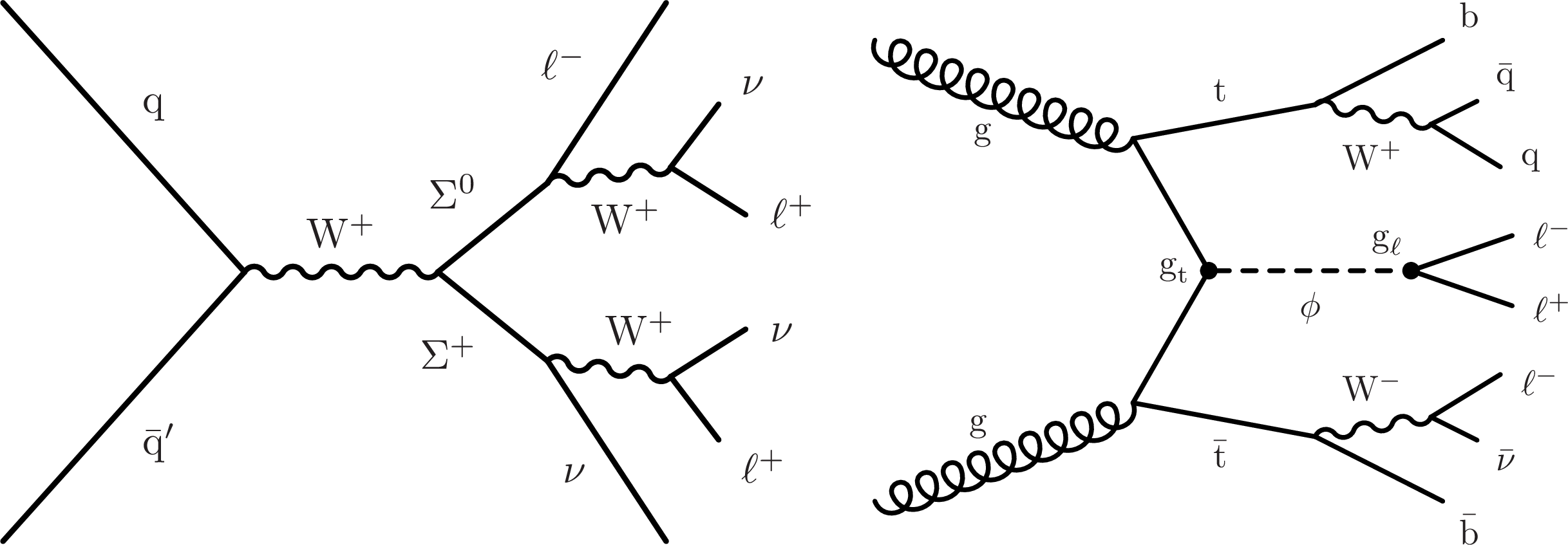
png pdf |
Figure 1:
Leading order Feynman diagrams for the type-III seesaw (left) and $ {{\mathrm{t} {}\mathrm{\bar{t}}} \phi}$ (right) signal models, depicting example production and decay modes in pp collisions. |

png pdf |
Figure 1-a:
Leading order Feynman diagram for the type-III seesaw signal model, depicting example production and decay modes in pp collisions. |

png pdf |
Figure 1-b:
Leading order Feynman diagram for the $ {{\mathrm{t} {}\mathrm{\bar{t}}} \phi}$ signal model, depicting example production and decay modes in pp collisions. |

png pdf |
Figure 2:
The $ {M_{\mathrm {T}}}$ distribution in the WZ-enriched control region (upper left), the $ {L_{\mathrm {T}}}$ distribution in the ${\mathrm{t} {}\mathrm{\bar{t}}} \mathrm{Z} $-enriched control region (upper right), the $ {S_{\mathrm {T}}}$ distribution in the $\mathrm{Z} \mathrm{Z} $-enriched control region (lower left), and the $ {L_{\mathrm {T}}}$ distribution in the misidentified-lepton (Z+jets) enriched control region (lower right). The lower panels show the ratio of observed to expected events. The hatched gray bands in the upper panels and the light gray bands in the lower panels represent the total (systematic and statistical) uncertainty of the backgrounds in each bin, whereas the dark gray bands in the lower panels represent only the statistical uncertainty of the backgrounds. The rightmost bins contain the overflow events in each distribution. |
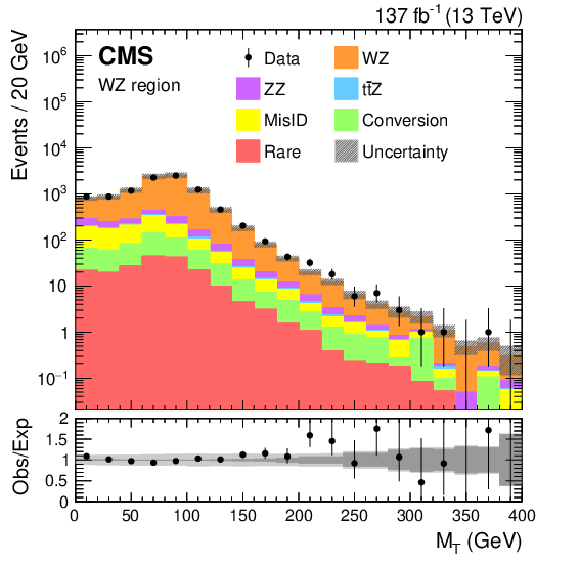
png pdf |
Figure 2-a:
The $ {M_{\mathrm {T}}}$ distribution in the WZ-enriched control region. The lower panel shows the ratio of observed to expected events. The hatched gray band in the upper panel and the light gray band in the lower panel represent the total (systematic and statistical) uncertainty of the backgrounds in each bin, whereas the dark gray band in the lower panels represent only the statistical uncertainty of the backgrounds. The rightmost bin contains the overflow events in the distribution. |

png pdf |
Figure 2-b:
The $ {L_{\mathrm {T}}}$ distribution in the ${\mathrm{t} {}\mathrm{\bar{t}}} \mathrm{Z} $-enriched control region. The lower panel shows the ratio of observed to expected events. The hatched gray band in the upper panel and the light gray band in the lower panel represent the total (systematic and statistical) uncertainty of the backgrounds in each bin, whereas the dark gray band in the lower panels represent only the statistical uncertainty of the backgrounds. The rightmost bin contains the overflow events in the distribution. |
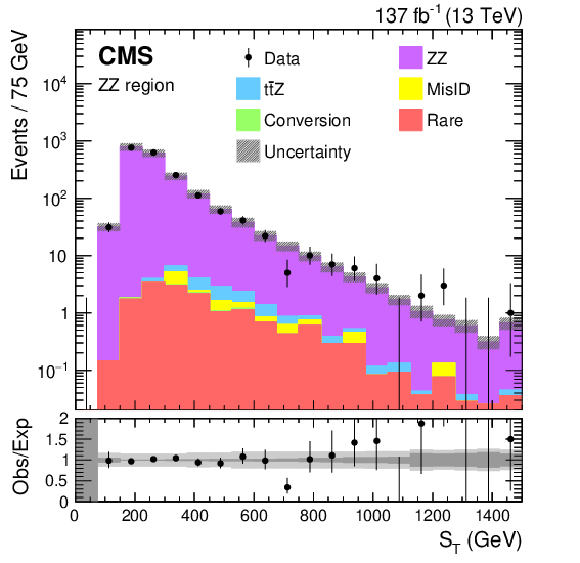
png pdf |
Figure 2-c:
The $ {S_{\mathrm {T}}}$ distribution in the $\mathrm{Z} \mathrm{Z} $-enriched control region. The lower panel shows the ratio of observed to expected events. The hatched gray band in the upper panel and the light gray band in the lower panel represent the total (systematic and statistical) uncertainty of the backgrounds in each bin, whereas the dark gray band in the lower panels represent only the statistical uncertainty of the backgrounds. The rightmost bin contains the overflow events in the distribution. |
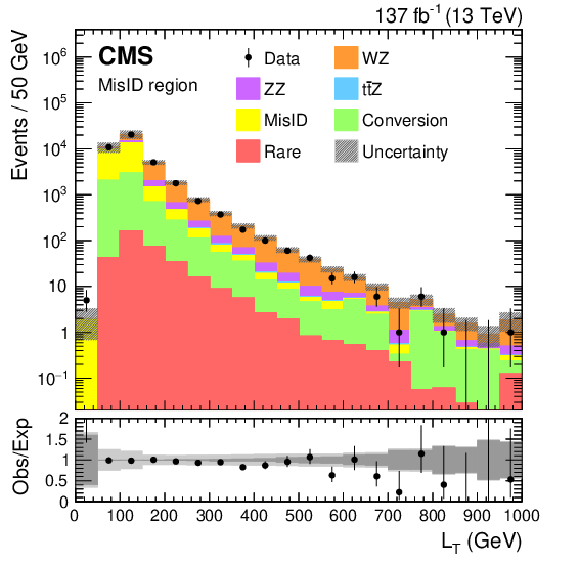
png pdf |
Figure 2-d:
The $ {L_{\mathrm {T}}}$ distribution in the misidentified-lepton (Z+jets) enriched control region. The lower panel shows the ratio of observed to expected events. The hatched gray band in the upper panel and the light gray band in the lower panel represent the total (systematic and statistical) uncertainty of the backgrounds in each bin, whereas the dark gray band in the lower panels represent only the statistical uncertainty of the backgrounds. The rightmost bin contains the overflow events in the distribution. |
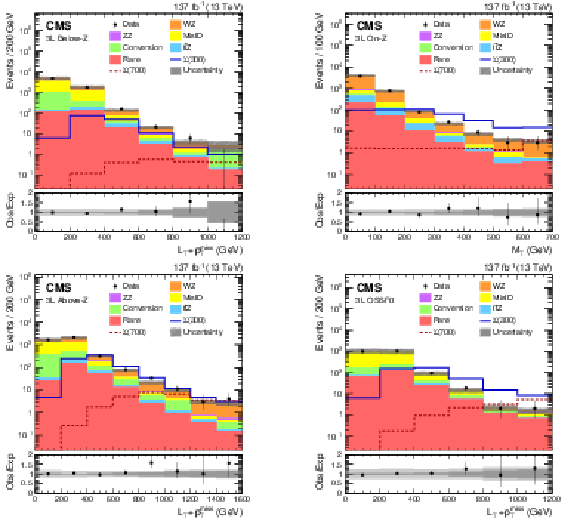
png pdf |
Figure 3:
Type-III seesaw signal regions in 3L below-Z (upper left), on-Z (upper right), above-Z (lower left), and OSSF0 (lower right) events. The total SM background is shown as a stacked histogram of all contributing processes. The predictions for type-III seesaw models with $\Sigma $ masses of 300 and 700 GeV in the flavor-democratic scenario are also shown. The lower panels show the ratio of observed to expected events. The hatched gray bands in the upper panels and the light gray bands in the lower panels represent the total (systematic and statistical) uncertainty of the backgrounds in each bin, whereas the dark gray bands in the lower panels represent only the statistical uncertainty of the backgrounds. The rightmost bins contain the overflow events in each distribution. |

png pdf |
Figure 3-a:
Type-III seesaw signal region in 3L below-Z events. The total SM background is shown as a stacked histogram of all contributing processes. The predictions for type-III seesaw models with $\Sigma $ masses of 300 and 700 GeV in the flavor-democratic scenario are also shown. The lower panel shows the ratio of observed to expected events. The hatched gray band in the upper panel and the light gray band in the lower panel represent the total (systematic and statistical) uncertainty of the backgrounds in each bin, whereas the dark gray bands in the lower panels represent only the statistical uncertainty of the backgrounds. The rightmost bin contains the overflow events in the distribution. |

png pdf |
Figure 3-b:
Type-III seesaw signal region in 3L on-Z events. The total SM background is shown as a stacked histogram of all contributing processes. The predictions for type-III seesaw models with $\Sigma $ masses of 300 and 700 GeV in the flavor-democratic scenario are also shown. The lower panel shows the ratio of observed to expected events. The hatched gray band in the upper panel and the light gray band in the lower panel represent the total (systematic and statistical) uncertainty of the backgrounds in each bin, whereas the dark gray bands in the lower panels represent only the statistical uncertainty of the backgrounds. The rightmost bin contains the overflow events in the distribution. |
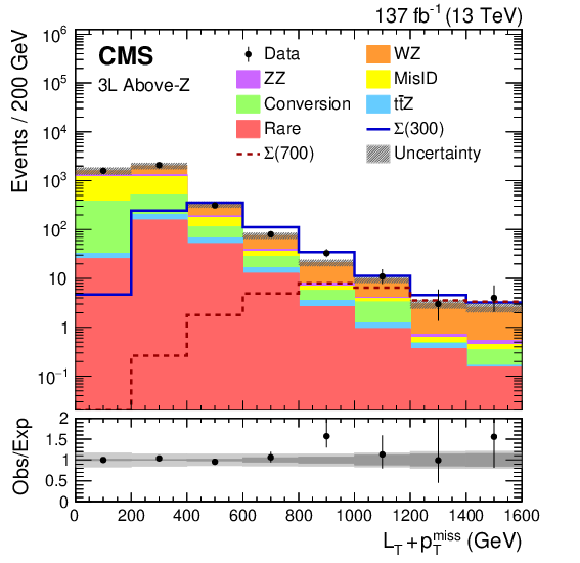
png pdf |
Figure 3-c:
Type-III seesaw signal region in 3L above-Z events. The total SM background is shown as a stacked histogram of all contributing processes. The predictions for type-III seesaw models with $\Sigma $ masses of 300 and 700 GeV in the flavor-democratic scenario are also shown. The lower panel shows the ratio of observed to expected events. The hatched gray band in the upper panel and the light gray band in the lower panel represent the total (systematic and statistical) uncertainty of the backgrounds in each bin, whereas the dark gray bands in the lower panels represent only the statistical uncertainty of the backgrounds. The rightmost bin contains the overflow events in the distribution. |
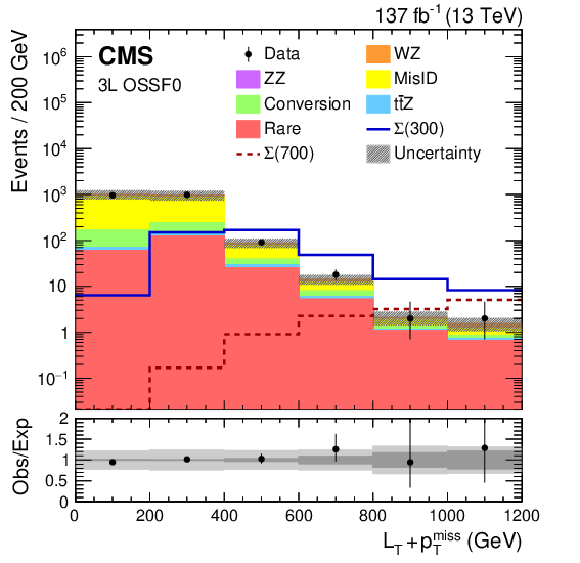
png pdf |
Figure 3-d:
Type-III seesaw signal region in 3L OSSF0 events. The total SM background is shown as a stacked histogram of all contributing processes. The predictions for type-III seesaw models with $\Sigma $ masses of 300 and 700 GeV in the flavor-democratic scenario are also shown. The lower panel shows the ratio of observed to expected events. The hatched gray band in the upper panel and the light gray band in the lower panel represent the total (systematic and statistical) uncertainty of the backgrounds in each bin, whereas the dark gray bands in the lower panels represent only the statistical uncertainty of the backgrounds. The rightmost bin contains the overflow events in the distribution. |

png pdf |
Figure 4:
Type-III seesaw signal regions in 4L OSSF0 (upper left), OSSF1 (upper right), and OSSF2 (lower) events. The total SM background is shown as a stacked histogram of all contributing processes. The predictions for type-III seesaw models with $\Sigma $ masses of 300 and 700 GeV in the flavor-democratic scenario are also shown. The lower panels show the ratio of observed to expected events. The hatched gray bands in the upper panels and the light gray bands in the lower panels represent the total (systematic and statistical) uncertainty of the backgrounds in each bin, whereas the dark gray bands in the lower panels represent only the statistical uncertainty of the backgrounds. The rightmost bins contain the overflow events in each distribution. |
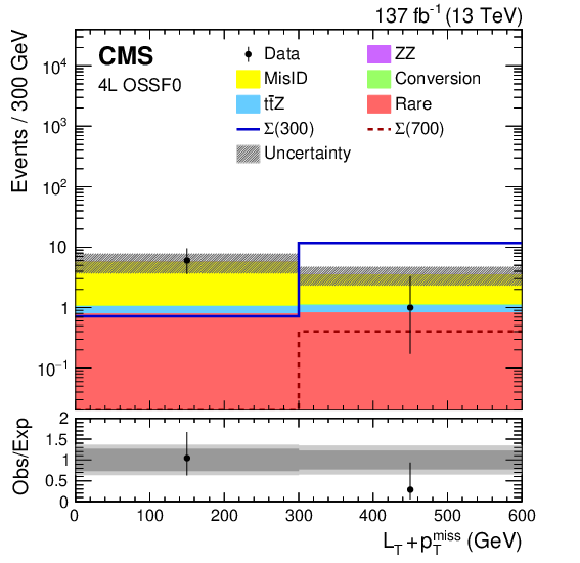
png pdf |
Figure 4-a:
Type-III seesaw signal region in 4L OSSF0 events. The total SM background is shown as a stacked histogram of all contributing processes. The predictions for type-III seesaw models with $\Sigma $ masses of 300 and 700 GeV in the flavor-democratic scenario are also shown. The lower panel shows the ratio of observed to expected events. The hatched gray band in the upper panel and the light gray band in the lower panel represent the total (systematic and statistical) uncertainty of the backgrounds in each bin, whereas the dark gray band in the lower panel represent only the statistical uncertainty of the backgrounds. The rightmost bin contains the overflow events in each distribution. |

png pdf |
Figure 4-b:
Type-III seesaw signal region in 4L OSSF1 events. The total SM background is shown as a stacked histogram of all contributing processes. The predictions for type-III seesaw models with $\Sigma $ masses of 300 and 700 GeV in the flavor-democratic scenario are also shown. The lower panel shows the ratio of observed to expected events. The hatched gray band in the upper panel and the light gray band in the lower panel represent the total (systematic and statistical) uncertainty of the backgrounds in each bin, whereas the dark gray band in the lower panel represent only the statistical uncertainty of the backgrounds. The rightmost bin contains the overflow events in each distribution. |

png pdf |
Figure 4-c:
Type-III seesaw signal region in 4L OSSF2 events. The total SM background is shown as a stacked histogram of all contributing processes. The predictions for type-III seesaw models with $\Sigma $ masses of 300 and 700 GeV in the flavor-democratic scenario are also shown. The lower panel shows the ratio of observed to expected events. The hatched gray band in the upper panel and the light gray band in the lower panel represent the total (systematic and statistical) uncertainty of the backgrounds in each bin, whereas the dark gray band in the lower panel represent only the statistical uncertainty of the backgrounds. The rightmost bin contains the overflow events in each distribution. |
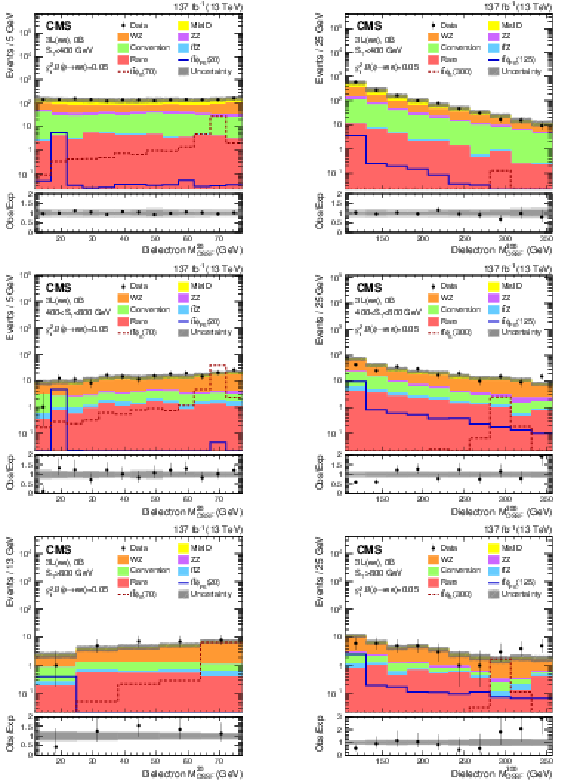
png pdf |
Figure 5:
Dielectron $ {M_{\mathrm {OSSF}}}^{20}$ (left column) and $ {M_{\mathrm {OSSF}}}^{300}$ (right column) distributions in the 3L(ee) 0B $ {{\mathrm{t} {}\mathrm{\bar{t}}} \phi}$ signal regions. Upper, center, and lower plots are for $ {S_{\mathrm {T}}} < $ 400 GeV, 400 $ < {S_{\mathrm {T}}} < $ 800 GeV, and $ {S_{\mathrm {T}}} > $ 800 GeV, respectively. The total SM background is shown as a stacked histogram of all contributing processes. The predictions for $ {{\mathrm{t} {}\mathrm{\bar{t}}} \phi}(\to {\mathrm{e} \mathrm{e}}$) models with a pseudoscalar (scalar) $\phi $ of 20 and 125 (70 and 300) GeV mass assuming $g_{\mathrm{t}}^2\mathcal {B}(\phi \to \mathrm{e} \mathrm{e})=$ 0.05 are also shown. The lower panels show the ratio of observed to expected events. The hatched gray bands in the upper panels and the light gray bands in the lower panels represent the total (systematic and statistical) uncertainty of the backgrounds in each bin, whereas the dark gray bands in the lower panels represent only the statistical uncertainty of the backgrounds. The rightmost bins do not contain the overflow events as these are outside the probed mass ranges. |
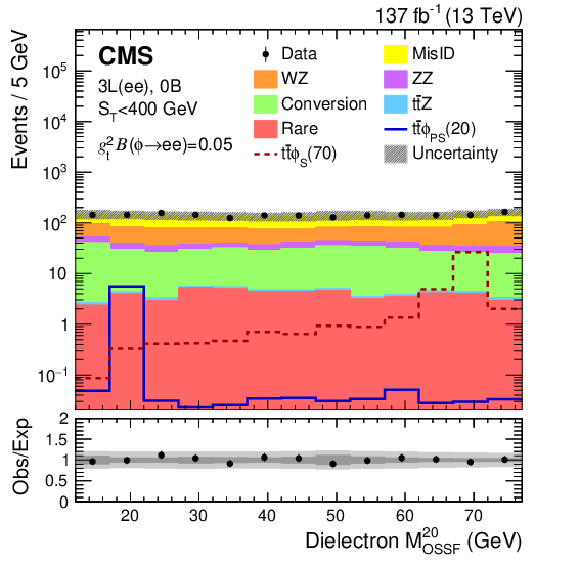
png pdf |
Figure 5-a:
Dielectron $ {M_{\mathrm {OSSF}}}^{20}$ distribution in the 3L(ee) 0B $ {{\mathrm{t} {}\mathrm{\bar{t}}} \phi}$ signal regions. The plot is for $ {S_{\mathrm {T}}} < $ 400 GeV. The total SM background is shown as a stacked histogram of all contributing processes. The predictions for $ {{\mathrm{t} {}\mathrm{\bar{t}}} \phi}(\to {\mathrm{e} \mathrm{e}}$) models with a pseudoscalar (scalar) $\phi $ of 20 and 125 (70 and 300) GeV mass assuming $g_{\mathrm{t}}^2\mathcal {B}(\phi \to \mathrm{e} \mathrm{e})=$ 0.05 are also shown. The lower panel shows the ratio of observed to expected events. The hatched gray band in the upper panel and the light gray band in the lower panel represent the total (systematic and statistical) uncertainty of the backgrounds in each bin, whereas the dark gray bands in the lower panel represents only the statistical uncertainty of the backgrounds. The rightmost bin does not contain the overflow events as these are outside the probed mass range. |
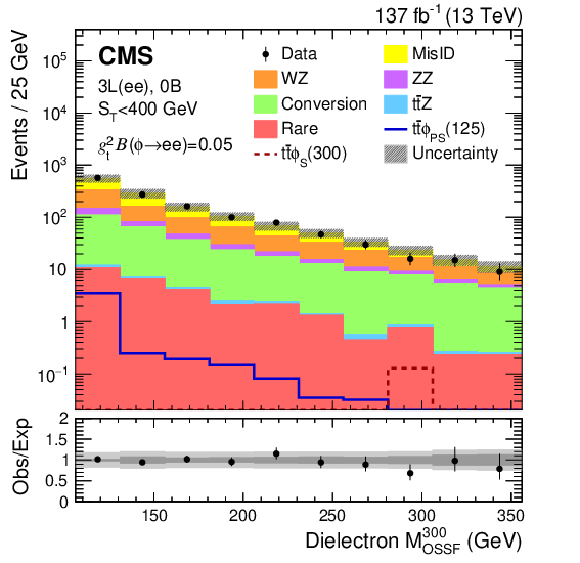
png pdf |
Figure 5-b:
Dielectron $ {M_{\mathrm {OSSF}}}^{300}$ distribution in the 3L(ee) 0B $ {{\mathrm{t} {}\mathrm{\bar{t}}} \phi}$ signal regions. The plot is for $ {S_{\mathrm {T}}} < $ 400 GeV. The total SM background is shown as a stacked histogram of all contributing processes. The predictions for $ {{\mathrm{t} {}\mathrm{\bar{t}}} \phi}(\to {\mathrm{e} \mathrm{e}}$) models with a pseudoscalar (scalar) $\phi $ of 20 and 125 (70 and 300) GeV mass assuming $g_{\mathrm{t}}^2\mathcal {B}(\phi \to \mathrm{e} \mathrm{e})=$ 0.05 are also shown. The lower panel shows the ratio of observed to expected events. The hatched gray band in the upper panel and the light gray band in the lower panel represent the total (systematic and statistical) uncertainty of the backgrounds in each bin, whereas the dark gray bands in the lower panel represents only the statistical uncertainty of the backgrounds. The rightmost bin does not contain the overflow events as these are outside the probed mass range. |
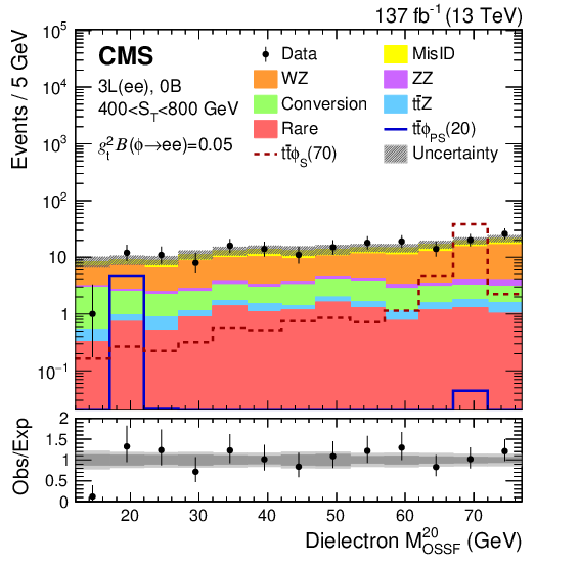
png pdf |
Figure 5-c:
Dielectron $ {M_{\mathrm {OSSF}}}^{20}$ distribution in the 3L(ee) 0B $ {{\mathrm{t} {}\mathrm{\bar{t}}} \phi}$ signal regions. The plot is for 400 $ < {S_{\mathrm {T}}} < $ 800 GeV. The total SM background is shown as a stacked histogram of all contributing processes. The predictions for $ {{\mathrm{t} {}\mathrm{\bar{t}}} \phi}(\to {\mathrm{e} \mathrm{e}}$) models with a pseudoscalar (scalar) $\phi $ of 20 and 125 (70 and 300) GeV mass assuming $g_{\mathrm{t}}^2\mathcal {B}(\phi \to \mathrm{e} \mathrm{e})=$ 0.05 are also shown. The lower panel shows the ratio of observed to expected events. The hatched gray band in the upper panel and the light gray band in the lower panel represent the total (systematic and statistical) uncertainty of the backgrounds in each bin, whereas the dark gray bands in the lower panel represents only the statistical uncertainty of the backgrounds. The rightmost bin does not contain the overflow events as these are outside the probed mass range. |
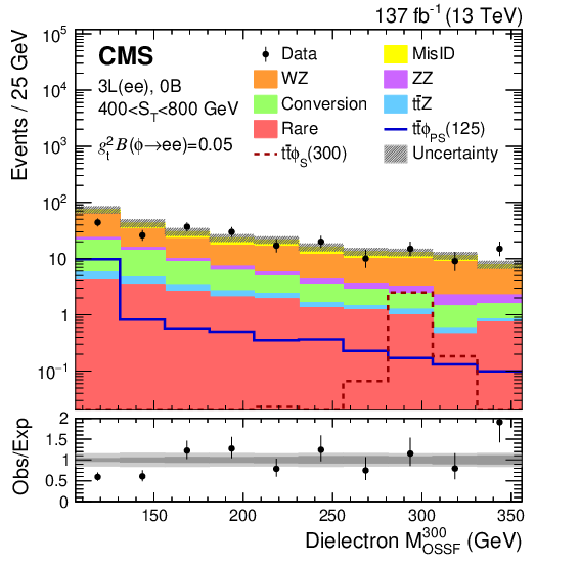
png pdf |
Figure 5-d:
Dielectron $ {M_{\mathrm {OSSF}}}^{300}$ distribution in the 3L(ee) 0B $ {{\mathrm{t} {}\mathrm{\bar{t}}} \phi}$ signal regions. The plot is for 400 $ < {S_{\mathrm {T}}} < $ 800 GeV. The total SM background is shown as a stacked histogram of all contributing processes. The predictions for $ {{\mathrm{t} {}\mathrm{\bar{t}}} \phi}(\to {\mathrm{e} \mathrm{e}}$) models with a pseudoscalar (scalar) $\phi $ of 20 and 125 (70 and 300) GeV mass assuming $g_{\mathrm{t}}^2\mathcal {B}(\phi \to \mathrm{e} \mathrm{e})=$ 0.05 are also shown. The lower panel shows the ratio of observed to expected events. The hatched gray band in the upper panel and the light gray band in the lower panel represent the total (systematic and statistical) uncertainty of the backgrounds in each bin, whereas the dark gray bands in the lower panel represents only the statistical uncertainty of the backgrounds. The rightmost bin does not contain the overflow events as these are outside the probed mass range. |
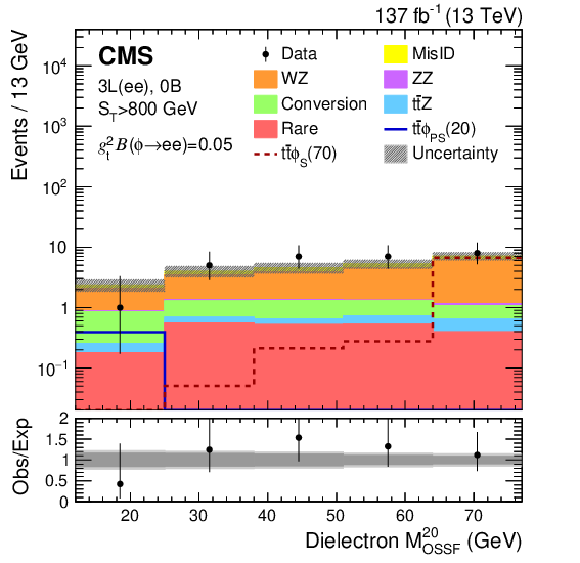
png pdf |
Figure 5-e:
Dielectron $ {M_{\mathrm {OSSF}}}^{20}$ distribution in the 3L(ee) 0B $ {{\mathrm{t} {}\mathrm{\bar{t}}} \phi}$ signal regions. The plot is for $ {S_{\mathrm {T}}} > $ 800 GeV. The total SM background is shown as a stacked histogram of all contributing processes. The predictions for $ {{\mathrm{t} {}\mathrm{\bar{t}}} \phi}(\to {\mathrm{e} \mathrm{e}}$) models with a pseudoscalar (scalar) $\phi $ of 20 and 125 (70 and 300) GeV mass assuming $g_{\mathrm{t}}^2\mathcal {B}(\phi \to \mathrm{e} \mathrm{e})=$ 0.05 are also shown. The lower panel shows the ratio of observed to expected events. The hatched gray band in the upper panel and the light gray band in the lower panel represent the total (systematic and statistical) uncertainty of the backgrounds in each bin, whereas the dark gray bands in the lower panel represents only the statistical uncertainty of the backgrounds. The rightmost bin does not contain the overflow events as these are outside the probed mass range. |

png pdf |
Figure 5-f:
Dielectron $ {M_{\mathrm {OSSF}}}^{300}$ distribution in the 3L(ee) 0B $ {{\mathrm{t} {}\mathrm{\bar{t}}} \phi}$ signal regions. The plot is for $ {S_{\mathrm {T}}} > $ 800 GeV. The total SM background is shown as a stacked histogram of all contributing processes. The predictions for $ {{\mathrm{t} {}\mathrm{\bar{t}}} \phi}(\to {\mathrm{e} \mathrm{e}}$) models with a pseudoscalar (scalar) $\phi $ of 20 and 125 (70 and 300) GeV mass assuming $g_{\mathrm{t}}^2\mathcal {B}(\phi \to \mathrm{e} \mathrm{e})=$ 0.05 are also shown. The lower panel shows the ratio of observed to expected events. The hatched gray band in the upper panel and the light gray band in the lower panel represent the total (systematic and statistical) uncertainty of the backgrounds in each bin, whereas the dark gray bands in the lower panel represents only the statistical uncertainty of the backgrounds. The rightmost bin does not contain the overflow events as these are outside the probed mass range. |
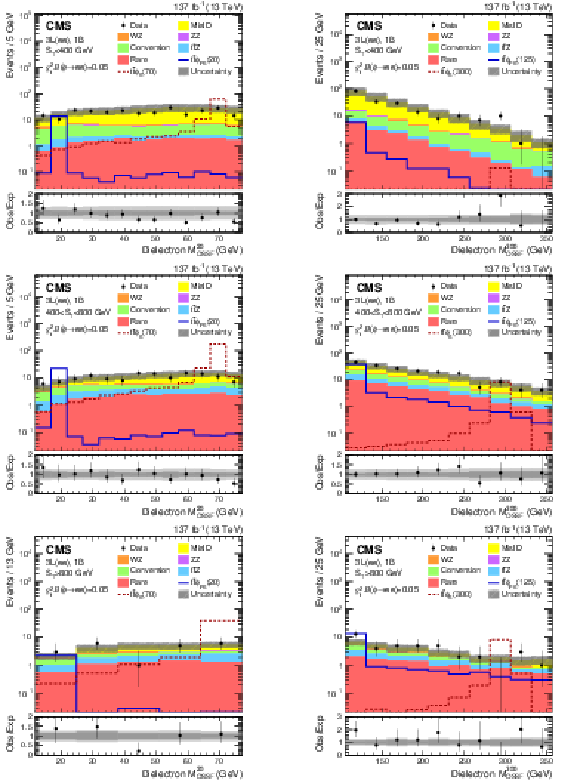
png pdf |
Figure 6:
Dielectron $ {M_{\mathrm {OSSF}}}^{20}$ (left column) and $ {M_{\mathrm {OSSF}}}^{300}$ (right column) distributions in the 3L(ee) 1B $ {{\mathrm{t} {}\mathrm{\bar{t}}} \phi}$ signal regions. Upper, center, and lower plots are for $ {S_{\mathrm {T}}} < $ 400 GeV, 400 $ < {S_{\mathrm {T}}} < $ 800 GeV, and $ {S_{\mathrm {T}}} > $ 800 GeV, respectively. The total SM background is shown as a stacked histogram of all contributing processes. The predictions for $ {{\mathrm{t} {}\mathrm{\bar{t}}} \phi}(\to {\mathrm{e} \mathrm{e}}$) models with a pseudoscalar (scalar) $\phi $ of 20 and 125 (70 and 300) GeV mass assuming $g_{\mathrm{t}}^2\mathcal {B}(\phi \to \mathrm{e} \mathrm{e})=$ 0.05 are also shown. The lower panels show the ratio of observed to expected events. The hatched gray bands in the upper panels and the light gray bands in the lower panels represent the total (systematic and statistical) uncertainty of the backgrounds in each bin, whereas the dark gray bands in the lower panels represent only the statistical uncertainty of the backgrounds. The rightmost bins do not contain the overflow events as these are outside the probed mass ranges. |

png pdf |
Figure 6-a:
Dielectron $ {M_{\mathrm {OSSF}}}^{20}$ distribution in the 3L(ee) 1B $ {{\mathrm{t} {}\mathrm{\bar{t}}} \phi}$ signal regions. The plot is for $ {S_{\mathrm {T}}} < $ 400 GeV. The total SM background is shown as a stacked histogram of all contributing processes. The predictions for $ {{\mathrm{t} {}\mathrm{\bar{t}}} \phi}(\to {\mathrm{e} \mathrm{e}}$) models with a pseudoscalar (scalar) $\phi $ of 20 and 125 (70 and 300) GeV mass assuming $g_{\mathrm{t}}^2\mathcal {B}(\phi \to \mathrm{e} \mathrm{e})=$ 0.05 are also shown. The lower panel shows the ratio of observed to expected events. The hatched gray band in the upper panel and the light gray band in the lower panel represent the total (systematic and statistical) uncertainty of the backgrounds in each bin, whereas the dark gray band in the lower panel representd only the statistical uncertainty of the backgrounds. The rightmost bin does not contain the overflow events as these are outside the probed mass range. |

png pdf |
Figure 6-b:
Dielectron $ {M_{\mathrm {OSSF}}}^{300}$ distribution in the 3L(ee) 1B $ {{\mathrm{t} {}\mathrm{\bar{t}}} \phi}$ signal regions. The plot is for $ {S_{\mathrm {T}}} < $ 400 GeV. The total SM background is shown as a stacked histogram of all contributing processes. The predictions for $ {{\mathrm{t} {}\mathrm{\bar{t}}} \phi}(\to {\mathrm{e} \mathrm{e}}$) models with a pseudoscalar (scalar) $\phi $ of 20 and 125 (70 and 300) GeV mass assuming $g_{\mathrm{t}}^2\mathcal {B}(\phi \to \mathrm{e} \mathrm{e})=$ 0.05 are also shown. The lower panel shows the ratio of observed to expected events. The hatched gray band in the upper panel and the light gray band in the lower panel represent the total (systematic and statistical) uncertainty of the backgrounds in each bin, whereas the dark gray band in the lower panel representd only the statistical uncertainty of the backgrounds. The rightmost bin does not contain the overflow events as these are outside the probed mass range. |
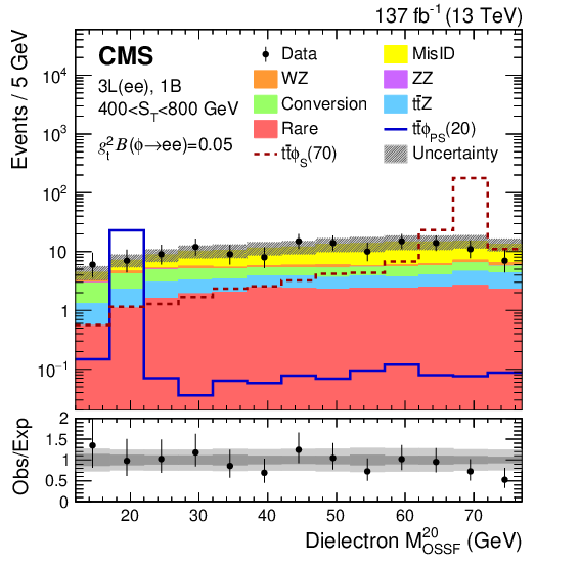
png pdf |
Figure 6-c:
Dielectron $ {M_{\mathrm {OSSF}}}^{20}$ distribution in the 3L(ee) 1B $ {{\mathrm{t} {}\mathrm{\bar{t}}} \phi}$ signal regions. The plot is for 400 $ < {S_{\mathrm {T}}} < $ 800 GeV. The total SM background is shown as a stacked histogram of all contributing processes. The predictions for $ {{\mathrm{t} {}\mathrm{\bar{t}}} \phi}(\to {\mathrm{e} \mathrm{e}}$) models with a pseudoscalar (scalar) $\phi $ of 20 and 125 (70 and 300) GeV mass assuming $g_{\mathrm{t}}^2\mathcal {B}(\phi \to \mathrm{e} \mathrm{e})=$ 0.05 are also shown. The lower panel shows the ratio of observed to expected events. The hatched gray band in the upper panel and the light gray band in the lower panel represent the total (systematic and statistical) uncertainty of the backgrounds in each bin, whereas the dark gray band in the lower panel representd only the statistical uncertainty of the backgrounds. The rightmost bin does not contain the overflow events as these are outside the probed mass range. |

png pdf |
Figure 6-d:
Dielectron $ {M_{\mathrm {OSSF}}}^{300}$ distribution in the 3L(ee) 1B $ {{\mathrm{t} {}\mathrm{\bar{t}}} \phi}$ signal regions. The plot is for 400 $ < {S_{\mathrm {T}}} < $ 800 GeV. The total SM background is shown as a stacked histogram of all contributing processes. The predictions for $ {{\mathrm{t} {}\mathrm{\bar{t}}} \phi}(\to {\mathrm{e} \mathrm{e}}$) models with a pseudoscalar (scalar) $\phi $ of 20 and 125 (70 and 300) GeV mass assuming $g_{\mathrm{t}}^2\mathcal {B}(\phi \to \mathrm{e} \mathrm{e})=$ 0.05 are also shown. The lower panel shows the ratio of observed to expected events. The hatched gray band in the upper panel and the light gray band in the lower panel represent the total (systematic and statistical) uncertainty of the backgrounds in each bin, whereas the dark gray band in the lower panel representd only the statistical uncertainty of the backgrounds. The rightmost bin does not contain the overflow events as these are outside the probed mass range. |
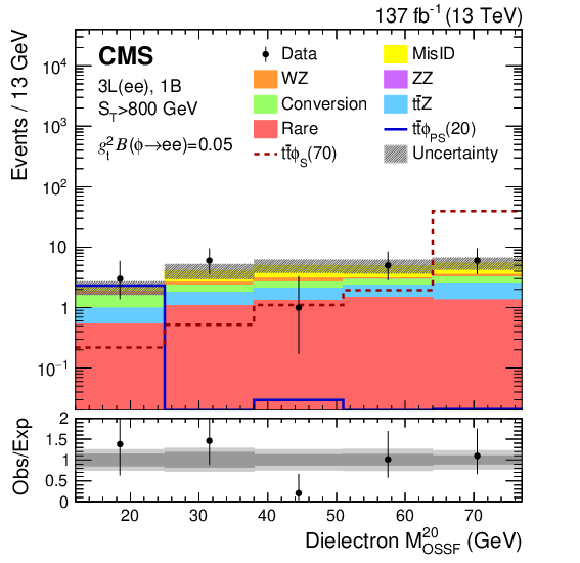
png pdf |
Figure 6-e:
Dielectron $ {M_{\mathrm {OSSF}}}^{20}$ distribution in the 3L(ee) 1B $ {{\mathrm{t} {}\mathrm{\bar{t}}} \phi}$ signal regions. The plot is for $ {S_{\mathrm {T}}} > $ 800 GeV. The total SM background is shown as a stacked histogram of all contributing processes. The predictions for $ {{\mathrm{t} {}\mathrm{\bar{t}}} \phi}(\to {\mathrm{e} \mathrm{e}}$) models with a pseudoscalar (scalar) $\phi $ of 20 and 125 (70 and 300) GeV mass assuming $g_{\mathrm{t}}^2\mathcal {B}(\phi \to \mathrm{e} \mathrm{e})=$ 0.05 are also shown. The lower panel shows the ratio of observed to expected events. The hatched gray band in the upper panel and the light gray band in the lower panel represent the total (systematic and statistical) uncertainty of the backgrounds in each bin, whereas the dark gray band in the lower panel representd only the statistical uncertainty of the backgrounds. The rightmost bin does not contain the overflow events as these are outside the probed mass range. |

png pdf |
Figure 6-f:
Dielectron $ {M_{\mathrm {OSSF}}}^{300}$ distribution in the 3L(ee) 1B $ {{\mathrm{t} {}\mathrm{\bar{t}}} \phi}$ signal regions. The plot is for $ {S_{\mathrm {T}}} > $ 800 GeV. The total SM background is shown as a stacked histogram of all contributing processes. The predictions for $ {{\mathrm{t} {}\mathrm{\bar{t}}} \phi}(\to {\mathrm{e} \mathrm{e}}$) models with a pseudoscalar (scalar) $\phi $ of 20 and 125 (70 and 300) GeV mass assuming $g_{\mathrm{t}}^2\mathcal {B}(\phi \to \mathrm{e} \mathrm{e})=$ 0.05 are also shown. The lower panel shows the ratio of observed to expected events. The hatched gray band in the upper panel and the light gray band in the lower panel represent the total (systematic and statistical) uncertainty of the backgrounds in each bin, whereas the dark gray band in the lower panel representd only the statistical uncertainty of the backgrounds. The rightmost bin does not contain the overflow events as these are outside the probed mass range. |
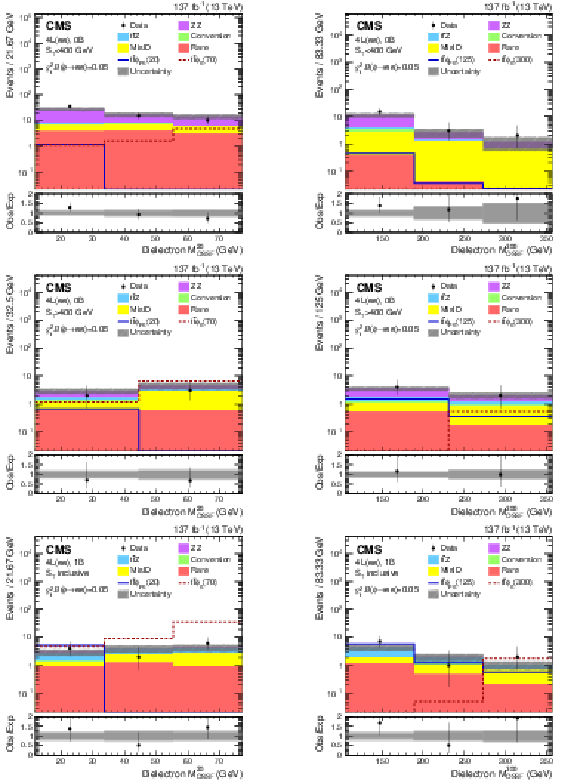
png pdf |
Figure 7:
Dielectron $ {M_{\mathrm {OSSF}}}^{20}$ (left column) and $ {M_{\mathrm {OSSF}}}^{300}$ (right column) distributions in the 4L(ee) $ {{\mathrm{t} {}\mathrm{\bar{t}}} \phi}$ signal regions. Upper, center, and lower plots are for 0B $ {S_{\mathrm {T}}} < $ 400 GeV, 0B $ {S_{\mathrm {T}}} > $ 400 GeV, and 1B $ {S_{\mathrm {T}}}$-inclusive, respectively. The total SM background is shown as a stacked histogram of all contributing processes. The predictions for $ {{\mathrm{t} {}\mathrm{\bar{t}}} \phi}(\to {\mathrm{e} \mathrm{e}}$) models with a pseudoscalar (scalar) $\phi $ of 20 and 125 (70 and 300) GeV mass assuming $g_{\mathrm{t}}^2\mathcal {B}(\phi \to \mathrm{e} \mathrm{e})=$ 0.05 are also shown. The lower panels show the ratio of observed to expected events. The hatched gray bands in the upper panels and the light gray bands in the lower panels represent the total (systematic and statistical) uncertainty of the backgrounds in each bin, whereas the dark gray bands in the lower panels represent only the statistical uncertainty of the backgrounds. The rightmost bins do not contain the overflow events as these are outside the probed mass range. |

png pdf |
Figure 7-a:
Dielectron $ {M_{\mathrm {OSSF}}}^{20}$ distribution in the 4L(ee) $ {{\mathrm{t} {}\mathrm{\bar{t}}} \phi}$ signal regions. The plots is for 0B $ {S_{\mathrm {T}}} < $ 400 GeV. The total SM background is shown as a stacked histogram of all contributing processes. The predictions for $ {{\mathrm{t} {}\mathrm{\bar{t}}} \phi}(\to {\mathrm{e} \mathrm{e}}$) models with a pseudoscalar (scalar) $\phi $ of 20 and 125 (70 and 300) GeV mass assuming $g_{\mathrm{t}}^2\mathcal {B}(\phi \to \mathrm{e} \mathrm{e})=$ 0.05 are also shown. The lower panel shows the ratio of observed to expected events. The hatched gray band in the upper panel and the light gray band in the lower panel represent the total (systematic and statistical) uncertainty of the backgrounds in each bin, whereas the dark gray band in the lower panel represents only the statistical uncertainty of the backgrounds. The rightmost bin doed not contain the overflow events as these are outside the probed mass range. |
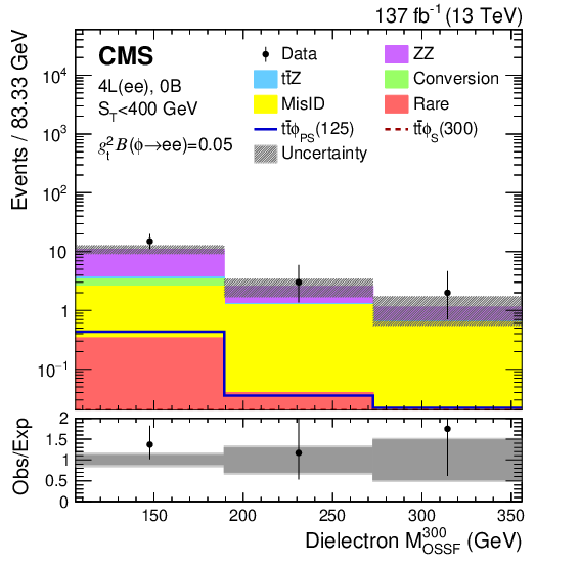
png pdf |
Figure 7-b:
Dielectron $ {M_{\mathrm {OSSF}}}^{300}$ distribution in the 4L(ee) $ {{\mathrm{t} {}\mathrm{\bar{t}}} \phi}$ signal regions. The plots is for 0B $ {S_{\mathrm {T}}} < $ 400 GeV. The total SM background is shown as a stacked histogram of all contributing processes. The predictions for $ {{\mathrm{t} {}\mathrm{\bar{t}}} \phi}(\to {\mathrm{e} \mathrm{e}}$) models with a pseudoscalar (scalar) $\phi $ of 20 and 125 (70 and 300) GeV mass assuming $g_{\mathrm{t}}^2\mathcal {B}(\phi \to \mathrm{e} \mathrm{e})=$ 0.05 are also shown. The lower panel shows the ratio of observed to expected events. The hatched gray band in the upper panel and the light gray band in the lower panel represent the total (systematic and statistical) uncertainty of the backgrounds in each bin, whereas the dark gray band in the lower panel represents only the statistical uncertainty of the backgrounds. The rightmost bin doed not contain the overflow events as these are outside the probed mass range. |
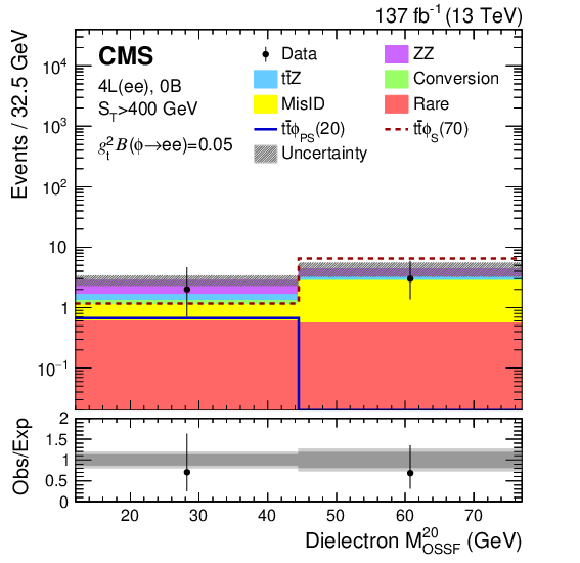
png pdf |
Figure 7-c:
Dielectron $ {M_{\mathrm {OSSF}}}^{20}$ distribution in the 4L(ee) $ {{\mathrm{t} {}\mathrm{\bar{t}}} \phi}$ signal regions. The plots is for 0B $ {S_{\mathrm {T}}} > $ 400 GeV. The total SM background is shown as a stacked histogram of all contributing processes. The predictions for $ {{\mathrm{t} {}\mathrm{\bar{t}}} \phi}(\to {\mathrm{e} \mathrm{e}}$) models with a pseudoscalar (scalar) $\phi $ of 20 and 125 (70 and 300) GeV mass assuming $g_{\mathrm{t}}^2\mathcal {B}(\phi \to \mathrm{e} \mathrm{e})=$ 0.05 are also shown. The lower panel shows the ratio of observed to expected events. The hatched gray band in the upper panel and the light gray band in the lower panel represent the total (systematic and statistical) uncertainty of the backgrounds in each bin, whereas the dark gray band in the lower panel represents only the statistical uncertainty of the backgrounds. The rightmost bin doed not contain the overflow events as these are outside the probed mass range. |
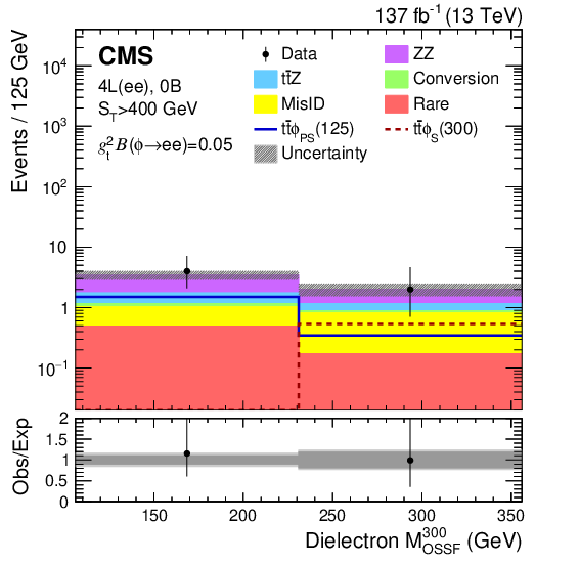
png pdf |
Figure 7-d:
Dielectron $ {M_{\mathrm {OSSF}}}^{300}$ distribution in the 4L(ee) $ {{\mathrm{t} {}\mathrm{\bar{t}}} \phi}$ signal regions. The plots is for 0B $ {S_{\mathrm {T}}} > $ 400 GeV. The total SM background is shown as a stacked histogram of all contributing processes. The predictions for $ {{\mathrm{t} {}\mathrm{\bar{t}}} \phi}(\to {\mathrm{e} \mathrm{e}}$) models with a pseudoscalar (scalar) $\phi $ of 20 and 125 (70 and 300) GeV mass assuming $g_{\mathrm{t}}^2\mathcal {B}(\phi \to \mathrm{e} \mathrm{e})=$ 0.05 are also shown. The lower panel shows the ratio of observed to expected events. The hatched gray band in the upper panel and the light gray band in the lower panel represent the total (systematic and statistical) uncertainty of the backgrounds in each bin, whereas the dark gray band in the lower panel represents only the statistical uncertainty of the backgrounds. The rightmost bin doed not contain the overflow events as these are outside the probed mass range. |
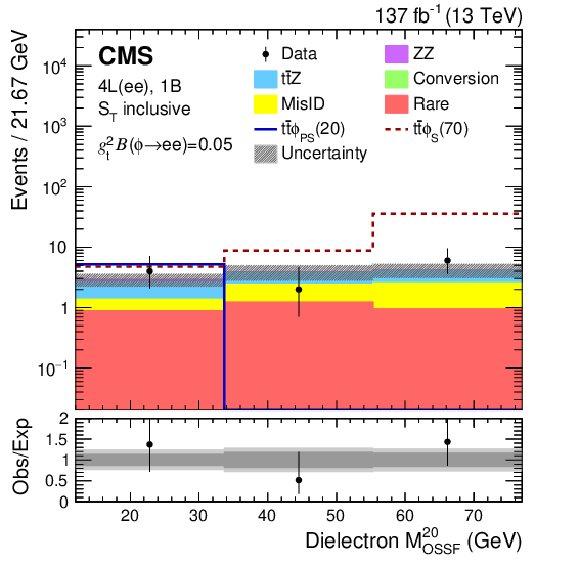
png pdf |
Figure 7-e:
Dielectron $ {M_{\mathrm {OSSF}}}^{20}$ distribution in the 4L(ee) $ {{\mathrm{t} {}\mathrm{\bar{t}}} \phi}$ signal regions. The plots is for 1B $ {S_{\mathrm {T}}}$-inclusive. The total SM background is shown as a stacked histogram of all contributing processes. The predictions for $ {{\mathrm{t} {}\mathrm{\bar{t}}} \phi}(\to {\mathrm{e} \mathrm{e}}$) models with a pseudoscalar (scalar) $\phi $ of 20 and 125 (70 and 300) GeV mass assuming $g_{\mathrm{t}}^2\mathcal {B}(\phi \to \mathrm{e} \mathrm{e})=$ 0.05 are also shown. The lower panel shows the ratio of observed to expected events. The hatched gray band in the upper panel and the light gray band in the lower panel represent the total (systematic and statistical) uncertainty of the backgrounds in each bin, whereas the dark gray band in the lower panel represents only the statistical uncertainty of the backgrounds. The rightmost bin doed not contain the overflow events as these are outside the probed mass range. |
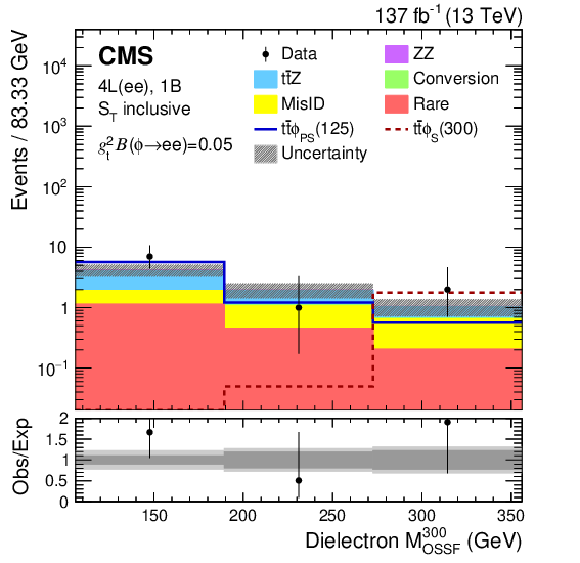
png pdf |
Figure 7-f:
Dielectron $ {M_{\mathrm {OSSF}}}^{300}$ distribution in the 4L(ee) $ {{\mathrm{t} {}\mathrm{\bar{t}}} \phi}$ signal regions. The plots is for 1B $ {S_{\mathrm {T}}}$-inclusive. The total SM background is shown as a stacked histogram of all contributing processes. The predictions for $ {{\mathrm{t} {}\mathrm{\bar{t}}} \phi}(\to {\mathrm{e} \mathrm{e}}$) models with a pseudoscalar (scalar) $\phi $ of 20 and 125 (70 and 300) GeV mass assuming $g_{\mathrm{t}}^2\mathcal {B}(\phi \to \mathrm{e} \mathrm{e})=$ 0.05 are also shown. The lower panel shows the ratio of observed to expected events. The hatched gray band in the upper panel and the light gray band in the lower panel represent the total (systematic and statistical) uncertainty of the backgrounds in each bin, whereas the dark gray band in the lower panel represents only the statistical uncertainty of the backgrounds. The rightmost bin doed not contain the overflow events as these are outside the probed mass range. |
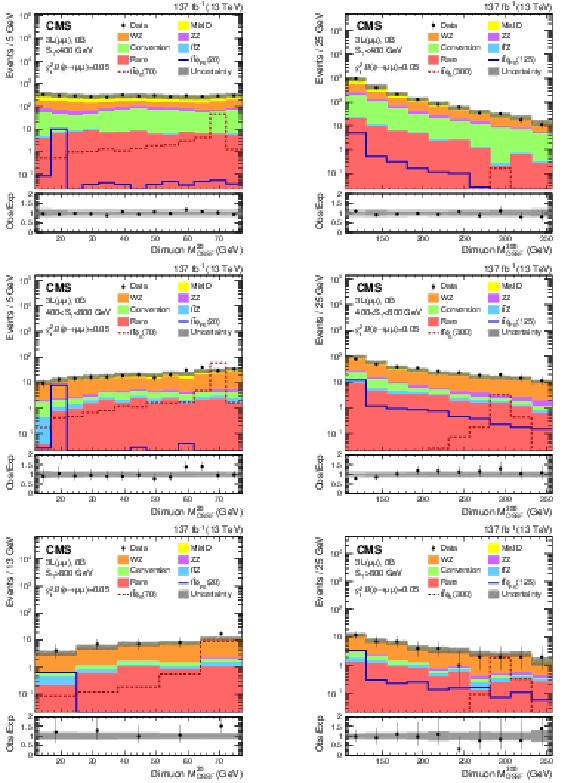
png pdf |
Figure 8:
Dimuon $ {M_{\mathrm {OSSF}}}^{20}$ (left column) and $ {M_{\mathrm {OSSF}}}^{300}$ (right column) distributions in the 3L($\mu \mu $) 0B $ {{\mathrm{t} {}\mathrm{\bar{t}}} \phi}$ signal regions. Upper, center, and lower plots are for $ {S_{\mathrm {T}}} < $ 400 GeV, 400 $ < {S_{\mathrm {T}}} < $ 800 GeV, and $ {S_{\mathrm {T}}} > $ 800 GeV, respectively. The total SM background is shown as a stacked histogram of all contributing processes. The predictions for $ {{\mathrm{t} {}\mathrm{\bar{t}}} \phi}(\to \mu \mu $) models with a pseudoscalar (scalar) $\phi $ of 20 and 125 (70 and 300) GeV mass assuming $g_{\mathrm{t}}^2\mathcal {B}(\phi \to \mu \mu)=$ 0.05 are also shown. The lower panels show the ratio of observed to expected events. The hatched gray bands in the upper panels and the light gray bands in the lower panels represent the total (systematic and statistical) uncertainty of the backgrounds in each bin, whereas the dark gray bands in the lower panels represent only the statistical uncertainty of the backgrounds. The rightmost bins do not contain the overflow events as these are outside the probed mass range. |
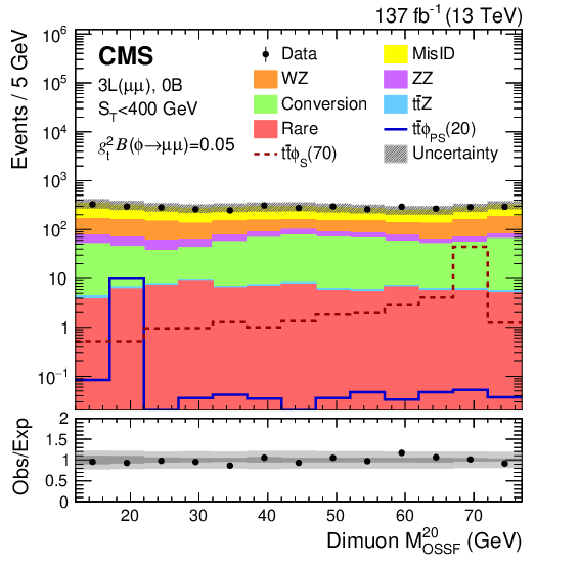
png pdf |
Figure 8-a:
Dimuon $ {M_{\mathrm {OSSF}}}^{20}$ distribution in the 3L($\mu \mu $) 0B $ {{\mathrm{t} {}\mathrm{\bar{t}}} \phi}$ signal regions. The plot is for $ {S_{\mathrm {T}}} < $ 400 GeV. The total SM background is shown as a stacked histogram of all contributing processes. The predictions for $ {{\mathrm{t} {}\mathrm{\bar{t}}} \phi}(\to \mu \mu $) models with a pseudoscalar (scalar) $\phi $ of 20 and 125 (70 and 300) GeV mass assuming $g_{\mathrm{t}}^2\mathcal {B}(\phi \to \mu \mu)=$ 0.05 are also shown. The lower panel shows the ratio of observed to expected events. The hatched gray band in the upper panel and the light gray bands in the lower panel represent the total (systematic and statistical) uncertainty of the backgrounds in each bin, whereas the dark gray band in the lower panel represents only the statistical uncertainty of the backgrounds. The rightmost bin does not contain the overflow events as these are outside the probed mass range. |
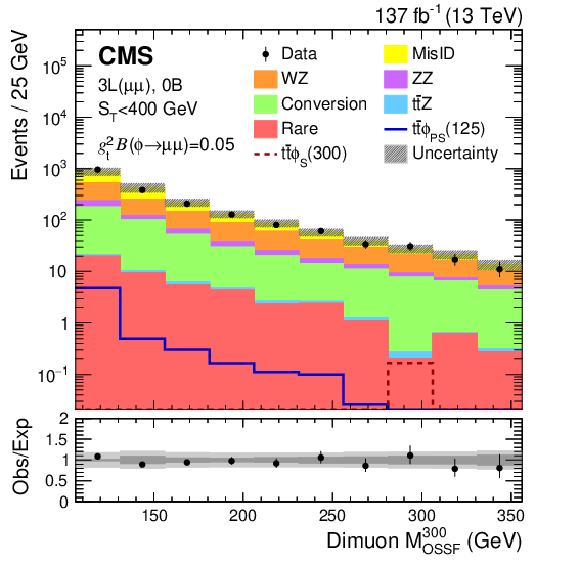
png pdf |
Figure 8-b:
Dimuon $ {M_{\mathrm {OSSF}}}^{300}$ distribution in the 3L($\mu \mu $) 0B $ {{\mathrm{t} {}\mathrm{\bar{t}}} \phi}$ signal regions. The plot is for $ {S_{\mathrm {T}}} < $ 400 GeV. The total SM background is shown as a stacked histogram of all contributing processes. The predictions for $ {{\mathrm{t} {}\mathrm{\bar{t}}} \phi}(\to \mu \mu $) models with a pseudoscalar (scalar) $\phi $ of 20 and 125 (70 and 300) GeV mass assuming $g_{\mathrm{t}}^2\mathcal {B}(\phi \to \mu \mu)=$ 0.05 are also shown. The lower panel shows the ratio of observed to expected events. The hatched gray band in the upper panel and the light gray bands in the lower panel represent the total (systematic and statistical) uncertainty of the backgrounds in each bin, whereas the dark gray band in the lower panel represents only the statistical uncertainty of the backgrounds. The rightmost bin does not contain the overflow events as these are outside the probed mass range. |
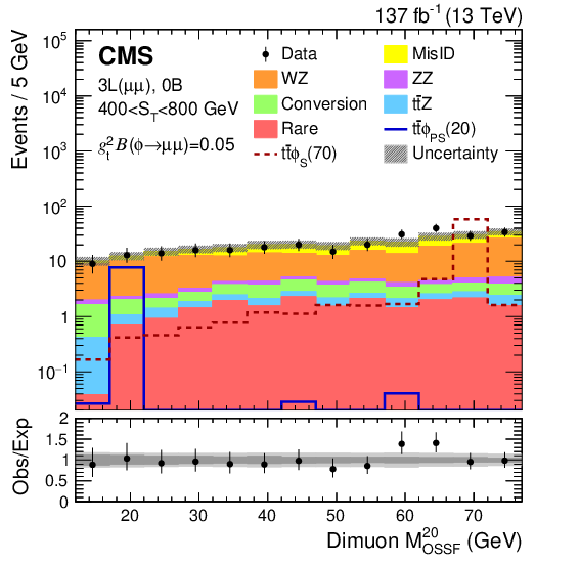
png pdf |
Figure 8-c:
Dimuon $ {M_{\mathrm {OSSF}}}^{20}$ distribution in the 3L($\mu \mu $) 0B $ {{\mathrm{t} {}\mathrm{\bar{t}}} \phi}$ signal regions. The plot is for 400 $ < {S_{\mathrm {T}}} < $ 800 GeV. The total SM background is shown as a stacked histogram of all contributing processes. The predictions for $ {{\mathrm{t} {}\mathrm{\bar{t}}} \phi}(\to \mu \mu $) models with a pseudoscalar (scalar) $\phi $ of 20 and 125 (70 and 300) GeV mass assuming $g_{\mathrm{t}}^2\mathcal {B}(\phi \to \mu \mu)=$ 0.05 are also shown. The lower panel shows the ratio of observed to expected events. The hatched gray band in the upper panel and the light gray bands in the lower panel represent the total (systematic and statistical) uncertainty of the backgrounds in each bin, whereas the dark gray band in the lower panel represents only the statistical uncertainty of the backgrounds. The rightmost bin does not contain the overflow events as these are outside the probed mass range. |
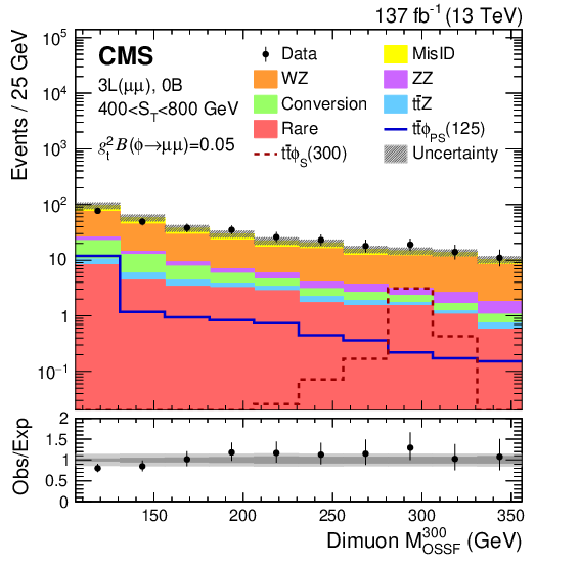
png pdf |
Figure 8-d:
Dimuon $ {M_{\mathrm {OSSF}}}^{300}$ distribution in the 3L($\mu \mu $) 0B $ {{\mathrm{t} {}\mathrm{\bar{t}}} \phi}$ signal regions. The plot is for 400 $ < {S_{\mathrm {T}}} < $ 800 GeV. The total SM background is shown as a stacked histogram of all contributing processes. The predictions for $ {{\mathrm{t} {}\mathrm{\bar{t}}} \phi}(\to \mu \mu $) models with a pseudoscalar (scalar) $\phi $ of 20 and 125 (70 and 300) GeV mass assuming $g_{\mathrm{t}}^2\mathcal {B}(\phi \to \mu \mu)=$ 0.05 are also shown. The lower panel shows the ratio of observed to expected events. The hatched gray band in the upper panel and the light gray bands in the lower panel represent the total (systematic and statistical) uncertainty of the backgrounds in each bin, whereas the dark gray band in the lower panel represents only the statistical uncertainty of the backgrounds. The rightmost bin does not contain the overflow events as these are outside the probed mass range. |

png pdf |
Figure 8-e:
Dimuon $ {M_{\mathrm {OSSF}}}^{20}$ distribution in the 3L($\mu \mu $) 0B $ {{\mathrm{t} {}\mathrm{\bar{t}}} \phi}$ signal regions. The plot is for $ {S_{\mathrm {T}}} > $ 800 GeV. The total SM background is shown as a stacked histogram of all contributing processes. The predictions for $ {{\mathrm{t} {}\mathrm{\bar{t}}} \phi}(\to \mu \mu $) models with a pseudoscalar (scalar) $\phi $ of 20 and 125 (70 and 300) GeV mass assuming $g_{\mathrm{t}}^2\mathcal {B}(\phi \to \mu \mu)=$ 0.05 are also shown. The lower panel shows the ratio of observed to expected events. The hatched gray band in the upper panel and the light gray bands in the lower panel represent the total (systematic and statistical) uncertainty of the backgrounds in each bin, whereas the dark gray band in the lower panel represents only the statistical uncertainty of the backgrounds. The rightmost bin does not contain the overflow events as these are outside the probed mass range. |

png pdf |
Figure 8-f:
Dimuon $ {M_{\mathrm {OSSF}}}^{300}$ distribution in the 3L($\mu \mu $) 0B $ {{\mathrm{t} {}\mathrm{\bar{t}}} \phi}$ signal regions. The plot is for $ {S_{\mathrm {T}}} > $ 800 GeV. The total SM background is shown as a stacked histogram of all contributing processes. The predictions for $ {{\mathrm{t} {}\mathrm{\bar{t}}} \phi}(\to \mu \mu $) models with a pseudoscalar (scalar) $\phi $ of 20 and 125 (70 and 300) GeV mass assuming $g_{\mathrm{t}}^2\mathcal {B}(\phi \to \mu \mu)=$ 0.05 are also shown. The lower panel shows the ratio of observed to expected events. The hatched gray band in the upper panel and the light gray bands in the lower panel represent the total (systematic and statistical) uncertainty of the backgrounds in each bin, whereas the dark gray band in the lower panel represents only the statistical uncertainty of the backgrounds. The rightmost bin does not contain the overflow events as these are outside the probed mass range. |

png pdf |
Figure 9:
Dimuon $ {M_{\mathrm {OSSF}}}^{20}$ (left column) and $ {M_{\mathrm {OSSF}}}^{300}$ (right column) distributions in the 3L($\mu \mu $) 1B $ {{\mathrm{t} {}\mathrm{\bar{t}}} \phi}$ signal regions. Upper, center, and lower plots are for $ {S_{\mathrm {T}}} < $ 400 GeV, 400 $ < {S_{\mathrm {T}}} < $ 800 GeV, and $ {S_{\mathrm {T}}} > $ 800 GeV, respectively. The total SM background is shown as a stacked histogram of all contributing processes. The predictions for $ {{\mathrm{t} {}\mathrm{\bar{t}}} \phi}(\to \mu \mu $) models with a pseudoscalar (scalar) $\phi $ of 20 and 125 (70 and 300) GeV mass assuming $g_{\mathrm{t}}^2\mathcal {B}(\phi \to \mu \mu)=$ 0.05 are also shown. The lower panels show the ratio of observed to expected events. The hatched gray bands in the upper panels and the light gray bands in the lower panels represent the total (systematic and statistical) uncertainty of the backgrounds in each bin, whereas the dark gray bands in the lower panels represent only the statistical uncertainty of the backgrounds. The rightmost bins do not contain the overflow events as these are outside the probed mass range. |

png pdf |
Figure 9-a:
Dimuon $ {M_{\mathrm {OSSF}}}^{20}$ distribution in the 3L($\mu \mu $) 1B $ {{\mathrm{t} {}\mathrm{\bar{t}}} \phi}$ signal regions. The plot is for $ {S_{\mathrm {T}}} < $ 400 GeV. The total SM background is shown as a stacked histogram of all contributing processes. The predictions for $ {{\mathrm{t} {}\mathrm{\bar{t}}} \phi}(\to \mu \mu $) models with a pseudoscalar (scalar) $\phi $ of 20 and 125 (70 and 300) GeV mass assuming $g_{\mathrm{t}}^2\mathcal {B}(\phi \to \mu \mu)=$ 0.05 are also shown. The lower panel shows the ratio of observed to expected events. The hatched gray bands in the upper panel and the light gray band in the lower panel represents the total (systematic and statistical) uncertainty of the backgrounds in each bin, whereas the dark gray band in the lower panel represents only the statistical uncertainty of the backgrounds. The rightmost bin does not contain the overflow events as these are outside the probed mass range. |

png pdf |
Figure 9-b:
Dimuon $ {M_{\mathrm {OSSF}}}^{300}$ distribution in the 3L($\mu \mu $) 1B $ {{\mathrm{t} {}\mathrm{\bar{t}}} \phi}$ signal regions. The plot is for $ {S_{\mathrm {T}}} < $ 400 GeV. The total SM background is shown as a stacked histogram of all contributing processes. The predictions for $ {{\mathrm{t} {}\mathrm{\bar{t}}} \phi}(\to \mu \mu $) models with a pseudoscalar (scalar) $\phi $ of 20 and 125 (70 and 300) GeV mass assuming $g_{\mathrm{t}}^2\mathcal {B}(\phi \to \mu \mu)=$ 0.05 are also shown. The lower panel shows the ratio of observed to expected events. The hatched gray bands in the upper panel and the light gray band in the lower panel represents the total (systematic and statistical) uncertainty of the backgrounds in each bin, whereas the dark gray band in the lower panel represents only the statistical uncertainty of the backgrounds. The rightmost bin does not contain the overflow events as these are outside the probed mass range. |
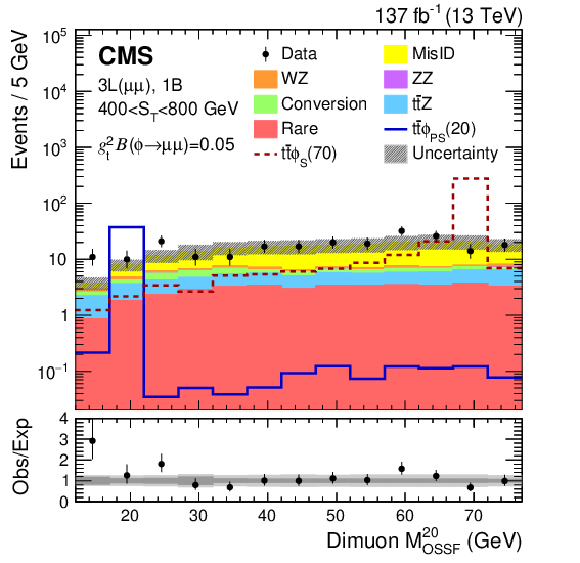
png pdf |
Figure 9-c:
Dimuon $ {M_{\mathrm {OSSF}}}^{20}$ distribution in the 3L($\mu \mu $) 1B $ {{\mathrm{t} {}\mathrm{\bar{t}}} \phi}$ signal regions. The plot is for 400 $ < {S_{\mathrm {T}}} < $ 800 GeV. The total SM background is shown as a stacked histogram of all contributing processes. The predictions for $ {{\mathrm{t} {}\mathrm{\bar{t}}} \phi}(\to \mu \mu $) models with a pseudoscalar (scalar) $\phi $ of 20 and 125 (70 and 300) GeV mass assuming $g_{\mathrm{t}}^2\mathcal {B}(\phi \to \mu \mu)=$ 0.05 are also shown. The lower panel shows the ratio of observed to expected events. The hatched gray bands in the upper panel and the light gray band in the lower panel represents the total (systematic and statistical) uncertainty of the backgrounds in each bin, whereas the dark gray band in the lower panel represents only the statistical uncertainty of the backgrounds. The rightmost bin does not contain the overflow events as these are outside the probed mass range. |
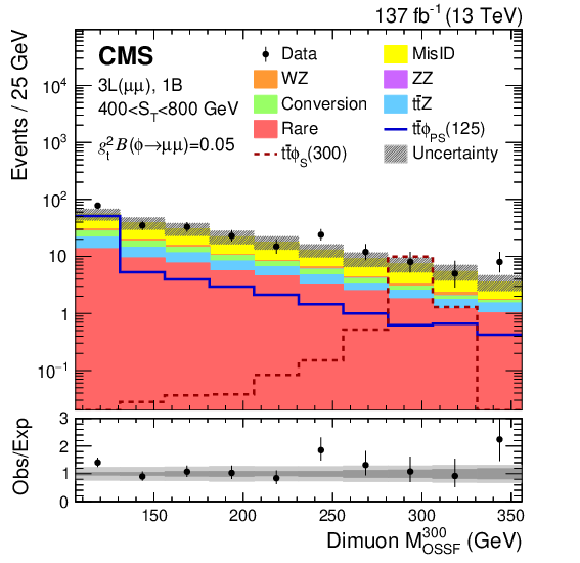
png pdf |
Figure 9-d:
Dimuon $ {M_{\mathrm {OSSF}}}^{300}$ distribution in the 3L($\mu \mu $) 1B $ {{\mathrm{t} {}\mathrm{\bar{t}}} \phi}$ signal regions. The plot is for 400 $ < {S_{\mathrm {T}}} < $ 800 GeV. The total SM background is shown as a stacked histogram of all contributing processes. The predictions for $ {{\mathrm{t} {}\mathrm{\bar{t}}} \phi}(\to \mu \mu $) models with a pseudoscalar (scalar) $\phi $ of 20 and 125 (70 and 300) GeV mass assuming $g_{\mathrm{t}}^2\mathcal {B}(\phi \to \mu \mu)=$ 0.05 are also shown. The lower panel shows the ratio of observed to expected events. The hatched gray bands in the upper panel and the light gray band in the lower panel represents the total (systematic and statistical) uncertainty of the backgrounds in each bin, whereas the dark gray band in the lower panel represents only the statistical uncertainty of the backgrounds. The rightmost bin does not contain the overflow events as these are outside the probed mass range. |
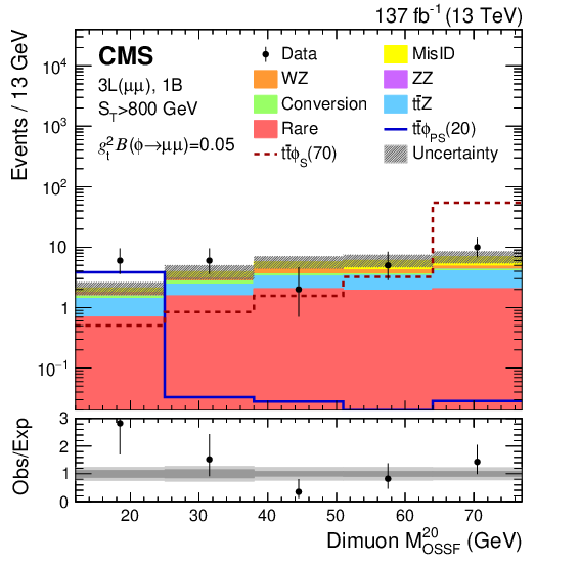
png pdf |
Figure 9-e:
Dimuon $ {M_{\mathrm {OSSF}}}^{20}$ distribution in the 3L($\mu \mu $) 1B $ {{\mathrm{t} {}\mathrm{\bar{t}}} \phi}$ signal regions. The plot is for $ {S_{\mathrm {T}}} > $ 800 GeV. The total SM background is shown as a stacked histogram of all contributing processes. The predictions for $ {{\mathrm{t} {}\mathrm{\bar{t}}} \phi}(\to \mu \mu $) models with a pseudoscalar (scalar) $\phi $ of 20 and 125 (70 and 300) GeV mass assuming $g_{\mathrm{t}}^2\mathcal {B}(\phi \to \mu \mu)=$ 0.05 are also shown. The lower panel shows the ratio of observed to expected events. The hatched gray bands in the upper panel and the light gray band in the lower panel represents the total (systematic and statistical) uncertainty of the backgrounds in each bin, whereas the dark gray band in the lower panel represents only the statistical uncertainty of the backgrounds. The rightmost bin does not contain the overflow events as these are outside the probed mass range. |
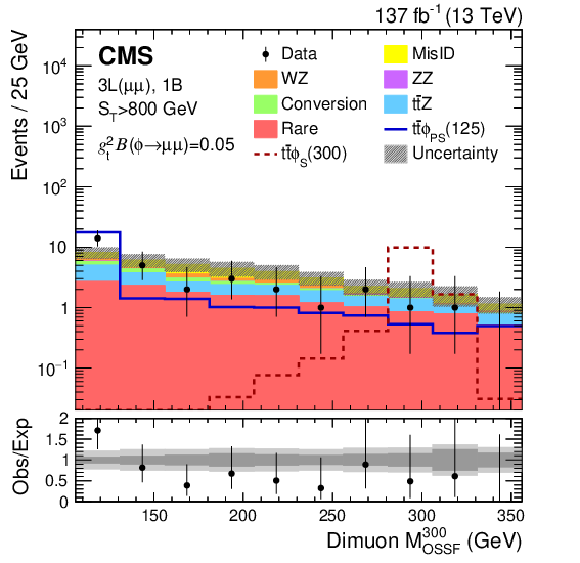
png pdf |
Figure 9-f:
Dimuon $ {M_{\mathrm {OSSF}}}^{300}$ distribution in the 3L($\mu \mu $) 1B $ {{\mathrm{t} {}\mathrm{\bar{t}}} \phi}$ signal regions. The plot is for $ {S_{\mathrm {T}}} > $ 800 GeV. The total SM background is shown as a stacked histogram of all contributing processes. The predictions for $ {{\mathrm{t} {}\mathrm{\bar{t}}} \phi}(\to \mu \mu $) models with a pseudoscalar (scalar) $\phi $ of 20 and 125 (70 and 300) GeV mass assuming $g_{\mathrm{t}}^2\mathcal {B}(\phi \to \mu \mu)=$ 0.05 are also shown. The lower panel shows the ratio of observed to expected events. The hatched gray bands in the upper panel and the light gray band in the lower panel represents the total (systematic and statistical) uncertainty of the backgrounds in each bin, whereas the dark gray band in the lower panel represents only the statistical uncertainty of the backgrounds. The rightmost bin does not contain the overflow events as these are outside the probed mass range. |
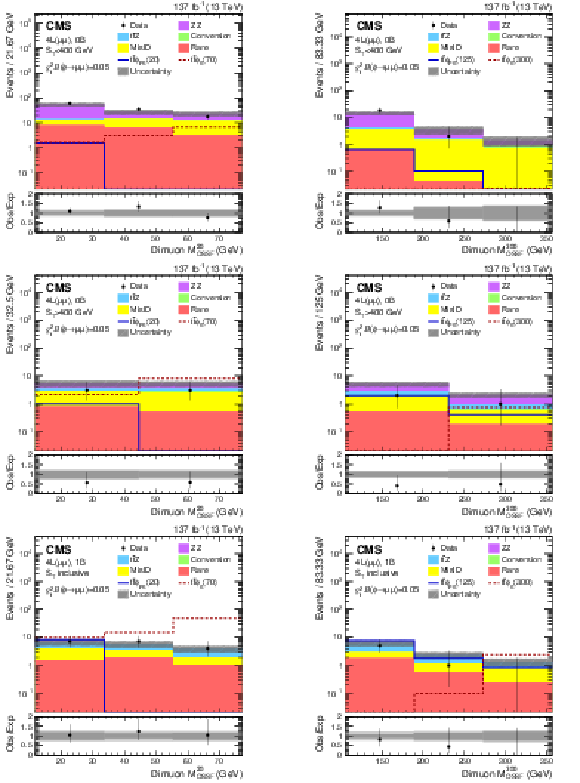
png pdf |
Figure 10:
Dimuon $ {M_{\mathrm {OSSF}}}^{20}$ (left column) and $ {M_{\mathrm {OSSF}}}^{300}$ (right column) distributions in the 4L($\mu \mu $) $ {{\mathrm{t} {}\mathrm{\bar{t}}} \phi}$ signal regions. Upper, center, and lower plots are for 0B $ {S_{\mathrm {T}}} < $ 400 GeV, 0B $ {S_{\mathrm {T}}} > $ 400 GeV, and 1B $ {S_{\mathrm {T}}}$-inclusive, respectively. The total SM background is shown as a stacked histogram of all contributing processes. The predictions for $ {{\mathrm{t} {}\mathrm{\bar{t}}} \phi}(\to \mu \mu $) models with a pseudoscalar (scalar) $\phi $ of 20 and 125 (70 and 300) GeV mass assuming $g_{\mathrm{t}}^2\mathcal {B}(\phi \to \mu \mu)=$ 0.05 are also shown. The lower panels show the ratio of observed to expected events. The hatched gray bands in the upper panels and the light gray bands in the lower panels represent the total (systematic and statistical) uncertainty of the backgrounds in each bin, whereas the dark gray bands in the lower panels represent only the statistical uncertainty of the backgrounds. The rightmost bins do not contain the overflow events as these are outside the probed mass range. |
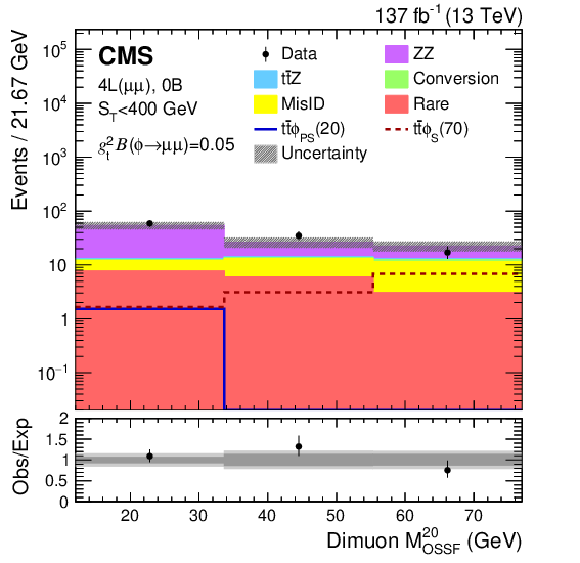
png pdf |
Figure 10-a:
Dimuon $ {M_{\mathrm {OSSF}}}^{20}$ distribution in the 4L($\mu \mu $) $ {{\mathrm{t} {}\mathrm{\bar{t}}} \phi}$ signal regions. The plot is for 0B $ {S_{\mathrm {T}}} < $ 400 GeV. The total SM background is shown as a stacked histogram of all contributing processes. The predictions for $ {{\mathrm{t} {}\mathrm{\bar{t}}} \phi}(\to \mu \mu $) models with a pseudoscalar (scalar) $\phi $ of 20 and 125 (70 and 300) GeV mass assuming $g_{\mathrm{t}}^2\mathcal {B}(\phi \to \mu \mu)=$ 0.05 are also shown. The lower panel shows the ratio of observed to expected events. The hatched gray band in the upper panel and the light gray band in the lower panel represent the total (systematic and statistical) uncertainty of the backgrounds in each bin, whereas the dark gray band in the lower panel represents only the statistical uncertainty of the backgrounds. The rightmost bin does not contain the overflow events as these are outside the probed mass range. |

png pdf |
Figure 10-b:
Dimuon $ {M_{\mathrm {OSSF}}}^{300}$ distribution in the 4L($\mu \mu $) $ {{\mathrm{t} {}\mathrm{\bar{t}}} \phi}$ signal regions. The plot is for 0B $ {S_{\mathrm {T}}} < $ 400 GeV. The total SM background is shown as a stacked histogram of all contributing processes. The predictions for $ {{\mathrm{t} {}\mathrm{\bar{t}}} \phi}(\to \mu \mu $) models with a pseudoscalar (scalar) $\phi $ of 20 and 125 (70 and 300) GeV mass assuming $g_{\mathrm{t}}^2\mathcal {B}(\phi \to \mu \mu)=$ 0.05 are also shown. The lower panel shows the ratio of observed to expected events. The hatched gray band in the upper panel and the light gray band in the lower panel represent the total (systematic and statistical) uncertainty of the backgrounds in each bin, whereas the dark gray band in the lower panel represents only the statistical uncertainty of the backgrounds. The rightmost bin does not contain the overflow events as these are outside the probed mass range. |

png pdf |
Figure 10-c:
Dimuon $ {M_{\mathrm {OSSF}}}^{20}$ distribution in the 4L($\mu \mu $) $ {{\mathrm{t} {}\mathrm{\bar{t}}} \phi}$ signal regions. The plot is for 0B $ {S_{\mathrm {T}}} > $ 400 GeV. The total SM background is shown as a stacked histogram of all contributing processes. The predictions for $ {{\mathrm{t} {}\mathrm{\bar{t}}} \phi}(\to \mu \mu $) models with a pseudoscalar (scalar) $\phi $ of 20 and 125 (70 and 300) GeV mass assuming $g_{\mathrm{t}}^2\mathcal {B}(\phi \to \mu \mu)=$ 0.05 are also shown. The lower panel shows the ratio of observed to expected events. The hatched gray band in the upper panel and the light gray band in the lower panel represent the total (systematic and statistical) uncertainty of the backgrounds in each bin, whereas the dark gray band in the lower panel represents only the statistical uncertainty of the backgrounds. The rightmost bin does not contain the overflow events as these are outside the probed mass range. |

png pdf |
Figure 10-d:
Dimuon $ {M_{\mathrm {OSSF}}}^{300}$ distribution in the 4L($\mu \mu $) $ {{\mathrm{t} {}\mathrm{\bar{t}}} \phi}$ signal regions. The plot is for 0B $ {S_{\mathrm {T}}} > $ 400 GeV. The total SM background is shown as a stacked histogram of all contributing processes. The predictions for $ {{\mathrm{t} {}\mathrm{\bar{t}}} \phi}(\to \mu \mu $) models with a pseudoscalar (scalar) $\phi $ of 20 and 125 (70 and 300) GeV mass assuming $g_{\mathrm{t}}^2\mathcal {B}(\phi \to \mu \mu)=$ 0.05 are also shown. The lower panel shows the ratio of observed to expected events. The hatched gray band in the upper panel and the light gray band in the lower panel represent the total (systematic and statistical) uncertainty of the backgrounds in each bin, whereas the dark gray band in the lower panel represents only the statistical uncertainty of the backgrounds. The rightmost bin does not contain the overflow events as these are outside the probed mass range. |
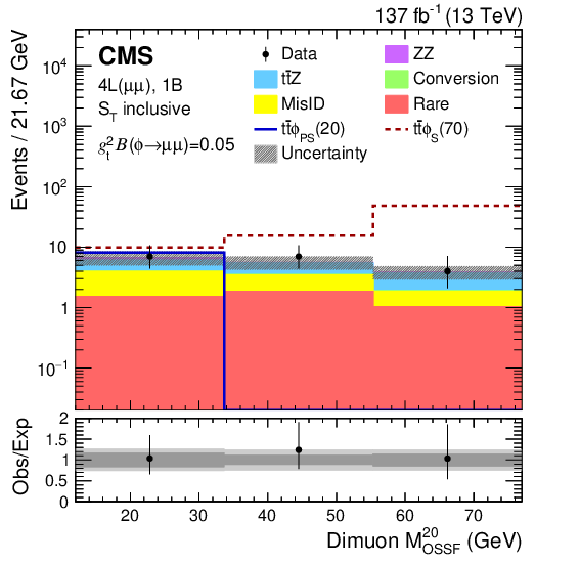
png pdf |
Figure 10-e:
Dimuon $ {M_{\mathrm {OSSF}}}^{20}$ distribution in the 4L($\mu \mu $) $ {{\mathrm{t} {}\mathrm{\bar{t}}} \phi}$ signal regions. The plot is for 1B $ {S_{\mathrm {T}}}$-inclusive. The total SM background is shown as a stacked histogram of all contributing processes. The predictions for $ {{\mathrm{t} {}\mathrm{\bar{t}}} \phi}(\to \mu \mu $) models with a pseudoscalar (scalar) $\phi $ of 20 and 125 (70 and 300) GeV mass assuming $g_{\mathrm{t}}^2\mathcal {B}(\phi \to \mu \mu)=$ 0.05 are also shown. The lower panel shows the ratio of observed to expected events. The hatched gray band in the upper panel and the light gray band in the lower panel represent the total (systematic and statistical) uncertainty of the backgrounds in each bin, whereas the dark gray band in the lower panel represents only the statistical uncertainty of the backgrounds. The rightmost bin does not contain the overflow events as these are outside the probed mass range. |
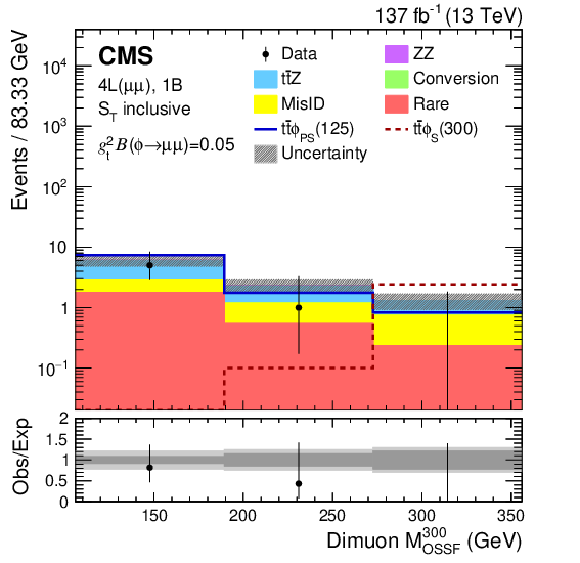
png pdf |
Figure 10-f:
Dimuon $ {M_{\mathrm {OSSF}}}^{300}$ distribution in the 4L($\mu \mu $) $ {{\mathrm{t} {}\mathrm{\bar{t}}} \phi}$ signal regions. The plot is for 1B $ {S_{\mathrm {T}}}$-inclusive. The total SM background is shown as a stacked histogram of all contributing processes. The predictions for $ {{\mathrm{t} {}\mathrm{\bar{t}}} \phi}(\to \mu \mu $) models with a pseudoscalar (scalar) $\phi $ of 20 and 125 (70 and 300) GeV mass assuming $g_{\mathrm{t}}^2\mathcal {B}(\phi \to \mu \mu)=$ 0.05 are also shown. The lower panel shows the ratio of observed to expected events. The hatched gray band in the upper panel and the light gray band in the lower panel represent the total (systematic and statistical) uncertainty of the backgrounds in each bin, whereas the dark gray band in the lower panel represents only the statistical uncertainty of the backgrounds. The rightmost bin does not contain the overflow events as these are outside the probed mass range. |

png pdf |
Figure 11:
The 95% confidence level expected and observed upper limits on the total production cross section of heavy fermion pairs. The inner (green) and the outer (yellow) bands indicate the regions containing 68 and 95%, respectively, of the distribution of limits expected under the background-only hypothesis. Also shown are the theoretical prediction for the cross section and the associated uncertainty of the $\Sigma $ pair production via the type-III seesaw mechanism. Type-III seesaw heavy fermions are excluded for masses below 880 GeV (expected limit 930 GeV) in the flavor-democratic scenario. |

png pdf |
Figure 12:
The 95% confidence level expected and observed upper limits on the product of the signal production cross section and branching fraction of a scalar $\phi $ boson in the dielectron (upper left) and dimuon (lower left) channels, and of a pseudoscalar $\phi $ boson in the dielectron (upper right) and dimuon (lower right) channels, where $\phi $ is produced in association with a top quark pair. The inner (green) and the outer (yellow) bands indicate the regions containing 68 and 95%, respectively, of the distribution of limits expected under the background-only hypothesis. The vertical hatched gray band indicates the mass region corresponding to the Z boson veto. Also shown are the theoretical predictions for the product of the production cross section and branching fraction of the $ {{\mathrm{t} {}\mathrm{\bar{t}}} \phi}$ model, with their uncertainties, and assuming ${g}_{t}^2\mathcal {B}(\phi \to {\mathrm{e} \mathrm{e}}/\mu \mu)=$ 0.05. All $ {{\mathrm{t} {}\mathrm{\bar{t}}} \phi}$ signal scenarios are excluded for production cross sections above 20 fb for $\phi $ masses in the range of 15-75 GeV, and above 5 fb for $\phi $ masses in the range of 108-340 GeV. |

png pdf |
Figure 12-a:
The 95% confidence level expected and observed upper limits on the product of the signal production cross section and branching fraction of a scalar $\phi $ boson in the dielectron channel, where $\phi $ is produced in association with a top quark pair. The inner (green) and the outer (yellow) bands indicate the regions containing 68 and 95%, respectively, of the distribution of limits expected under the background-only hypothesis. The vertical hatched gray band indicates the mass region corresponding to the Z boson veto. Also shown are the theoretical predictions for the product of the production cross section and branching fraction of the $ {{\mathrm{t} {}\mathrm{\bar{t}}} \phi}$ model, with their uncertainties, and assuming ${g}_{t}^2\mathcal {B}(\phi \to {\mathrm{e} \mathrm{e}}/\mu \mu)=$ 0.05. All $ {{\mathrm{t} {}\mathrm{\bar{t}}} \phi}$ signal scenarios are excluded for production cross sections above 20 fb for $\phi $ masses in the range of 15-75 GeV, and above 5 fb for $\phi $ masses in the range of 108-340 GeV. |
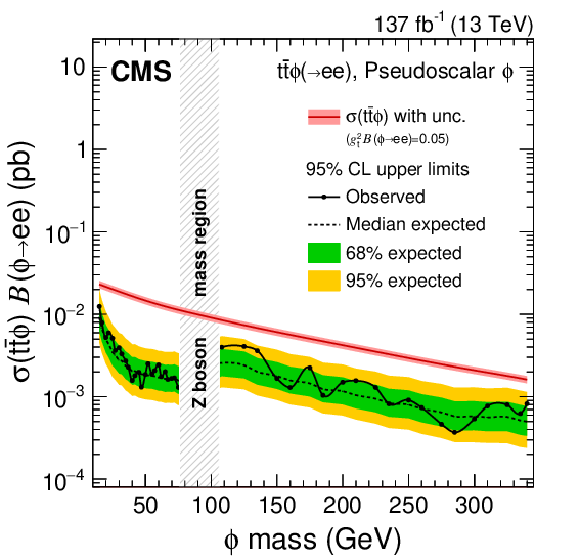
png pdf |
Figure 12-b:
The 95% confidence level expected and observed upper limits on the product of the signal production cross section and branching fraction of a scalar $\phi $ boson in the dimuon channel, where $\phi $ is produced in association with a top quark pair. The inner (green) and the outer (yellow) bands indicate the regions containing 68 and 95%, respectively, of the distribution of limits expected under the background-only hypothesis. The vertical hatched gray band indicates the mass region corresponding to the Z boson veto. Also shown are the theoretical predictions for the product of the production cross section and branching fraction of the $ {{\mathrm{t} {}\mathrm{\bar{t}}} \phi}$ model, with their uncertainties, and assuming ${g}_{t}^2\mathcal {B}(\phi \to {\mathrm{e} \mathrm{e}}/\mu \mu)=$ 0.05. All $ {{\mathrm{t} {}\mathrm{\bar{t}}} \phi}$ signal scenarios are excluded for production cross sections above 20 fb for $\phi $ masses in the range of 15-75 GeV, and above 5 fb for $\phi $ masses in the range of 108-340 GeV. |
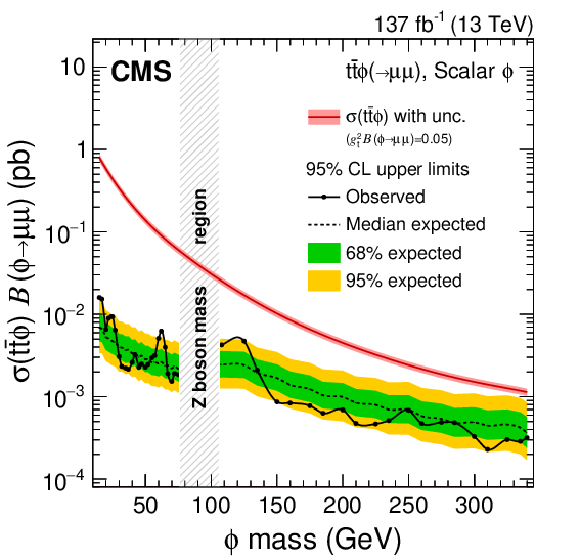
png pdf |
Figure 12-c:
The 95% confidence level expected and observed upper limits on the product of the signal production cross section and branching fraction of a pseudoscalar $\phi $ boson in the dielectron channel, where $\phi $ is produced in association with a top quark pair. The inner (green) and the outer (yellow) bands indicate the regions containing 68 and 95%, respectively, of the distribution of limits expected under the background-only hypothesis. The vertical hatched gray band indicates the mass region corresponding to the Z boson veto. Also shown are the theoretical predictions for the product of the production cross section and branching fraction of the $ {{\mathrm{t} {}\mathrm{\bar{t}}} \phi}$ model, with their uncertainties, and assuming ${g}_{t}^2\mathcal {B}(\phi \to {\mathrm{e} \mathrm{e}}/\mu \mu)=$ 0.05. All $ {{\mathrm{t} {}\mathrm{\bar{t}}} \phi}$ signal scenarios are excluded for production cross sections above 20 fb for $\phi $ masses in the range of 15-75 GeV, and above 5 fb for $\phi $ masses in the range of 108-340 GeV. |
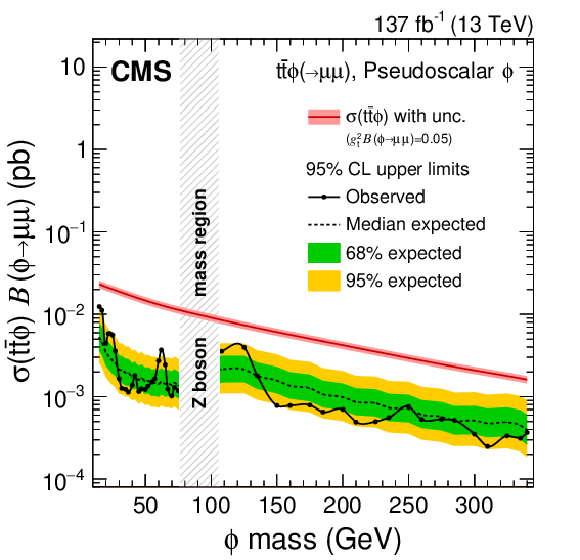
png pdf |
Figure 12-d:
The 95% confidence level expected and observed upper limits on the product of the signal production cross section and branching fraction of a pseudoscalar $\phi $ boson in the dimuon channel, where $\phi $ is produced in association with a top quark pair. The inner (green) and the outer (yellow) bands indicate the regions containing 68 and 95%, respectively, of the distribution of limits expected under the background-only hypothesis. The vertical hatched gray band indicates the mass region corresponding to the Z boson veto. Also shown are the theoretical predictions for the product of the production cross section and branching fraction of the $ {{\mathrm{t} {}\mathrm{\bar{t}}} \phi}$ model, with their uncertainties, and assuming ${g}_{t}^2\mathcal {B}(\phi \to {\mathrm{e} \mathrm{e}}/\mu \mu)=$ 0.05. All $ {{\mathrm{t} {}\mathrm{\bar{t}}} \phi}$ signal scenarios are excluded for production cross sections above 20 fb for $\phi $ masses in the range of 15-75 GeV, and above 5 fb for $\phi $ masses in the range of 108-340 GeV. |
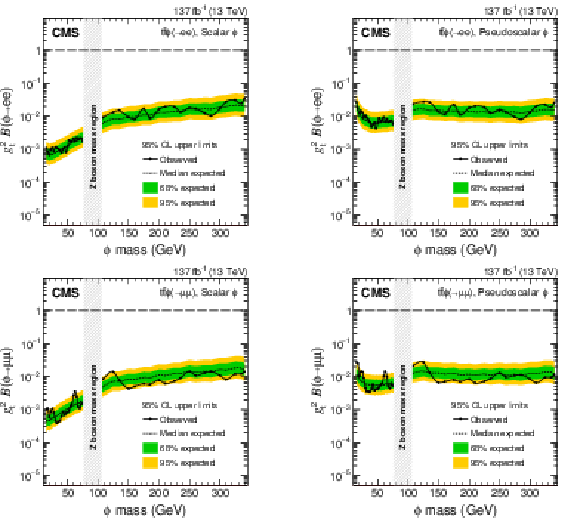
png pdf |
Figure 13:
The 95% confidence level expected and observed upper limits on the product of the square of the Yukawa coupling to top quarks and branching fraction of a scalar $\phi $ boson in the dielectron (upper left) and dimuon (lower left) channels, and of a pseudoscalar $\phi $ boson in the dielectron (upper right) and dimuon (lower right) channels, where $\phi $ is produced in association with a top quark pair. The inner (green) and the outer (yellow) bands indicate the regions containing 68 and 95%, respectively, of the distribution of limits expected under the background-only hypothesis. The vertical hatched gray band indicates the mass region corresponding to the Z boson veto. The dashed horizontal line marks the unity value of the product of the square of the Yukawa coupling to top quarks and the branching fraction. Assuming a Yukawa coupling of unit strength to top quarks, the branching fraction of new scalar (pseudoscalar) bosons to dielectrons or dimuons above 0.004 (0.03) are excluded for masses in the range of 15-75 GeV, and above 0.04 (0.03) for masses in the range of 108-340 GeV. |

png pdf |
Figure 13-a:
The 95% confidence level expected and observed upper limits on the product of the square of the Yukawa coupling to top quarks and branching fraction of a scalar $\phi $ boson in the dielectron channel, where $\phi $ is produced in association with a top quark pair. The inner (green) and the outer (yellow) bands indicate the regions containing 68 and 95%, respectively, of the distribution of limits expected under the background-only hypothesis. The vertical hatched gray band indicates the mass region corresponding to the Z boson veto. The dashed horizontal line marks the unity value of the product of the square of the Yukawa coupling to top quarks and the branching fraction. Assuming a Yukawa coupling of unit strength to top quarks, the branching fraction of new scalar (pseudoscalar) bosons to dielectrons or dimuons above 0.004 (0.03) are excluded for masses in the range of 15-75 GeV, and above 0.04 (0.03) for masses in the range of 108-340 GeV. |
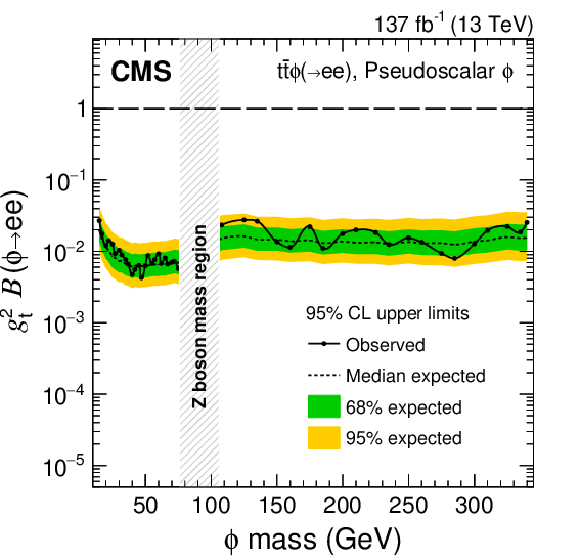
png pdf |
Figure 13-b:
The 95% confidence level expected and observed upper limits on the product of the square of the Yukawa coupling to top quarks and branching fraction of a scalar $\phi $ boson in the dimuon channel, where $\phi $ is produced in association with a top quark pair. The inner (green) and the outer (yellow) bands indicate the regions containing 68 and 95%, respectively, of the distribution of limits expected under the background-only hypothesis. The vertical hatched gray band indicates the mass region corresponding to the Z boson veto. The dashed horizontal line marks the unity value of the product of the square of the Yukawa coupling to top quarks and the branching fraction. Assuming a Yukawa coupling of unit strength to top quarks, the branching fraction of new scalar (pseudoscalar) bosons to dielectrons or dimuons above 0.004 (0.03) are excluded for masses in the range of 15-75 GeV, and above 0.04 (0.03) for masses in the range of 108-340 GeV. |

png pdf |
Figure 13-c:
The 95% confidence level expected and observed upper limits on the product of the square of the Yukawa coupling to top quarks and branching fraction of a pseudoscalar $\phi $ boson in the dielectron channel, where $\phi $ is produced in association with a top quark pair. The inner (green) and the outer (yellow) bands indicate the regions containing 68 and 95%, respectively, of the distribution of limits expected under the background-only hypothesis. The vertical hatched gray band indicates the mass region corresponding to the Z boson veto. The dashed horizontal line marks the unity value of the product of the square of the Yukawa coupling to top quarks and the branching fraction. Assuming a Yukawa coupling of unit strength to top quarks, the branching fraction of new scalar (pseudoscalar) bosons to dielectrons or dimuons above 0.004 (0.03) are excluded for masses in the range of 15-75 GeV, and above 0.04 (0.03) for masses in the range of 108-340 GeV. |
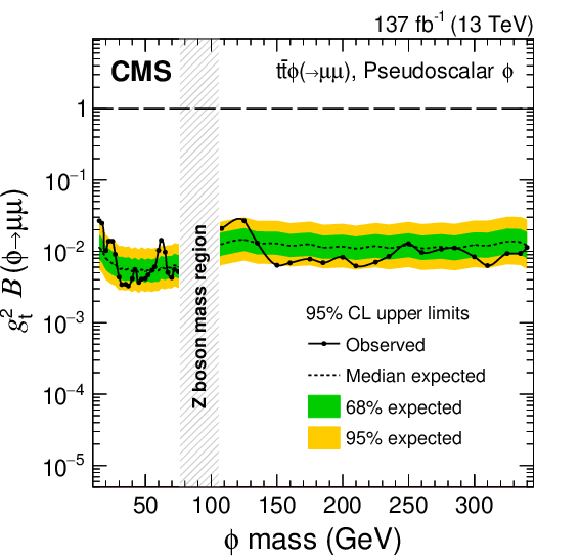
png pdf |
Figure 13-d:
The 95% confidence level expected and observed upper limits on the product of the square of the Yukawa coupling to top quarks and branching fraction of a pseudoscalar $\phi $ boson in the dimuon channel, where $\phi $ is produced in association with a top quark pair. The inner (green) and the outer (yellow) bands indicate the regions containing 68 and 95%, respectively, of the distribution of limits expected under the background-only hypothesis. The vertical hatched gray band indicates the mass region corresponding to the Z boson veto. The dashed horizontal line marks the unity value of the product of the square of the Yukawa coupling to top quarks and the branching fraction. Assuming a Yukawa coupling of unit strength to top quarks, the branching fraction of new scalar (pseudoscalar) bosons to dielectrons or dimuons above 0.004 (0.03) are excluded for masses in the range of 15-75 GeV, and above 0.04 (0.03) for masses in the range of 108-340 GeV. |
| Tables | |

png pdf |
Table 1:
Multilepton signal region definitions for the type-III seesaw signal model. All events containing a same-flavor lepton pair with invariant mass below 12 GeV are removed in the 3L and 4L event categories. Furthermore, 3L events containing an OSSF lepton pair with mass below 76 GeV when the trilepton mass is within a Z boson mass window (91 $\pm$ 15 GeV) are also rejected. The last $ {L_{\mathrm {T}}}+ {{p_{\mathrm {T}}} ^\text {miss}}$ or $ {M_{\mathrm {T}}}$ bin in each signal region contains the overflow events. |

png pdf |
Table 2:
Multilepton signal region definitions for the $ {{\mathrm{t} {}\mathrm{\bar{t}}} \phi}$ signal model. All events containing a same-flavor lepton pair with invariant mass below 12 GeV are removed in the 3L and 4L event categories. Furthermore, 3L events containing an OSSF lepton pair with mass below 76 GeV when the trilepton mass is within a Z boson mass window (91 $\pm$ 15 GeV) are also rejected. |

png pdf |
Table 3:
Sources of systematic uncertainties, affected background and signal processes, relative variations of the affected processes, and presence or otherwise of correlation between years in signal regions. |

png pdf |
Table 4:
Product of the fiducial acceptance and the event selection efficiency for the signal models at various signal mass hypotheses calculated after all analysis selection requirements. |
| Summary |
| A search has been performed for physics beyond the standard model, using multilepton events in 137 fb$^{-1}$ of pp collision data at $\sqrt{s} = $ 13 TeV, collected with the CMS detector in 2016-2018. The observations are found to be consistent with the expectations from standard model processes, with no statistically significant signal-like excess in any of the probed channels. The results are used to constrain the allowed parameter space of the targeted signal models. At 95% confidence level, heavy fermions of the type-III seesaw model with masses below 880 GeV are excluded assuming identical $\Sigma$ decay branching fractions across all lepton flavors. This is the most restrictive limit on the flavor-democratic scenario of the type-III seesaw model to date. Assuming a Yukawa coupling of unit strength to top quarks, branching fractions of new scalar (pseudoscalar) bosons to dielectrons or dimuons above 0.004 (0.03) are excluded at 95% confidence level for masses in the range 15-75 GeV, and above 0.04 (0.03) for masses in the range 108-340 GeV. These are the first limits in these channels on an extension of the standard model with scalar or pseudoscalar particles. |
| References | ||||
| 1 | P. Minkowski | $ \mu \to \mathrm{e}\gamma $ at a rate of one out of $ 10^{9} $ muon decays? | PLB 67 (1977) 421 | |
| 2 | R. N. Mohapatra and G. Senjanovic | Neutrino mass and spontaneous parity nonconservation | PRL 44 (1980) 912 | |
| 3 | M. Magg and C. Wetterich | Neutrino mass problem and gauge hierarchy | PLB 94 (1980) 61 | |
| 4 | R. N. Mohapatra and G. Senjanovic | Neutrino masses and mixings in gauge models with spontaneous parity violation | PRD 23 (1981) 165 | |
| 5 | J. Schechter and J. W. F. Valle | Neutrino masses in SU(2) x U(1) theories | PRD 22 (1980) 2227 | |
| 6 | J. Schechter and J. W. F. Valle | Neutrino decay and spontaneous violation of lepton number | PRD 25 (1982) 774 | |
| 7 | R. Foot, H. Lew, X. G. He, and G. C. Joshi | Seesaw neutrino masses induced by a triplet of leptons | Z. Phys. C 44 (1989) 441 | |
| 8 | R. N. Mohapatra | Mechanism for understanding small neutrino mass in superstring theories | PRL 56 (1986) 561 | |
| 9 | R. N. Mohapatra and J. W. F. Valle | Neutrino mass and baryon number nonconservation in superstring models | PRD 34 (1986) 1642 | |
| 10 | C. Biggio and F. Bonnet | Implementation of the type-III seesaw model in FeynRules/MadGraph and prospects for discovery with early LHC data | EPJC 72 (2012) 1899 | 1107.3463 |
| 11 | A. Abada et al. | $ \mu \to \mathrm{e}\gamma $ and $ \tau\to\ell\gamma $ decays in the fermion triplet seesaw model | PRD 78 (2008) 033007 | 0803.0481 |
| 12 | A. Abada et al. | Low energy effects of neutrino masses | JHEP 12 (2007) 061 | 0707.4058 |
| 13 | F. del Aguila, J. de Blas, and M. Perez-Victoria | Effects of new leptons in electroweak precision data | PRD 78 (2008) 013010 | 0803.4008 |
| 14 | D. Goswami and P. Poulose | Direct searches of type-III seesaw triplet fermions at high energy $ e^{+}e^{-} $ collider | EPJC 78 (2018) 42 | 1702.07215 |
| 15 | G. Cacciapaglia, G. Ferretti, T. Flacke, and H. Serodio | Light scalars in composite Higgs models | Front. Phys. 7 (2019) 22 | 1902.06890 |
| 16 | U. Ellwanger, C. Hugonie, and A. M. Teixeira | The next-to-minimal supersymmetric standard model | PR 496 (2010) 1 | 0910.1785 |
| 17 | M. Maniatis | The next-to-minimal supersymmetric extension of the standard model reviewed | Int. J. Mod. Phys. A 25 (2010) 3505 | 0906.0777 |
| 18 | M. R. Buckley, D. Feld, and D. Goncalves | Scalar simplified models for dark matter | PRD 91 (2015) 015017 | 1410.6497 |
| 19 | M. Casolino et al. | Probing a light CP-odd scalar in di-top-associated production at the LHC | EPJC 75 (2015) 498 | 1507.07004 |
| 20 | W.-F. Chang, T. Modak, and J. N. Ng | Signal for a light singlet scalar at the LHC | PRD 97 (2018) 055020 | 1711.05722 |
| 21 | CMS Collaboration | Search for heavy lepton partners of neutrinos in proton-proton collisions in the context of the type-III seesaw mechanism | PLB 718 (2012) 348 | CMS-EXO-11-073 1210.1797 |
| 22 | ATLAS Collaboration | Search for type-III seesaw heavy leptons in pp collisions at $ \sqrt{s}= $ 8 TeV with the ATLAS detector | PRD 92 (2015) 032001 | 1506.01839 |
| 23 | ATLAS Collaboration | Search for heavy lepton resonances decaying to a $ Z $ boson and a lepton in $ pp $ collisions at $ \sqrt{s}= $ 8 TeV with the ATLAS detector | JHEP 09 (2015) 108 | 1506.01291 |
| 24 | CMS Collaboration | Search for evidence of the type-III seesaw mechanism in multilepton final states in proton-proton collisions at $ \sqrt{s}=$ 13 TeV | PRL 119 (2017) 221802 | CMS-EXO-17-006 1708.07962 |
| 25 | CMS Collaboration | The CMS experiment at the CERN LHC | JINST 3 (2008) S08004 | CMS-00-001 |
| 26 | CMS Collaboration | The CMS trigger system | JINST 12 (2017) P01020 | CMS-TRG-12-001 1609.02366 |
| 27 | J. Alwall et al. | The automated computation of tree-level and next-to-leading order differential cross sections, and their matching to parton shower simulations | JHEP 07 (2014) 079 | 1405.0301 |
| 28 | P. Nason | A new method for combining NLO QCD with shower Monte Carlo algorithms | JHEP 11 (2004) 040 | hep-ph/0409146 |
| 29 | S. Frixione, P. Nason, and C. Oleari | Matching NLO QCD computations with parton shower simulations: the POWHEG method | JHEP 11 (2007) 070 | 0709.2092 |
| 30 | S. Alioli, P. Nason, C. Oleari, and E. Re | A general framework for implementing NLO calculations in shower Monte Carlo programs: the POWHEG BOX | JHEP 06 (2010) 043 | 1002.2581 |
| 31 | J. M. Campbell and R. K. Ellis | MCFM for the Tevatron and the LHC | NPPS 205--206 (2010) 10 | 1007.3492 |
| 32 | Y. Gao et al. | Spin determination of single-produced resonances at hadron colliders | PRD 81 (2010) 075022 | 1001.3396 |
| 33 | S. Bolognesi et al. | On the spin and parity of a single-produced resonance at the LHC | PRD 86 (2012) 095031 | 1208.4018 |
| 34 | I. Anderson et al. | Constraining anomalous HVV interactions at proton and lepton colliders | PRD 89 (2014) 035007 | 1309.4819 |
| 35 | A. V. Gritsan, R. Rontsch, M. Schulze, and M. Xiao | Constraining anomalous Higgs boson couplings to the heavy flavor fermions using matrix element techniques | PRD 94 (2016) 055023 | 1606.03107 |
| 36 | B. Fuks, M. Klasen, D. R. Lamprea, and M. Rothering | Gaugino production in proton-proton collisions at a center-of-mass energy of 8 TeV | JHEP 10 (2012) 081 | 1207.2159 |
| 37 | B. Fuks, M. Klasen, D. R. Lamprea, and M. Rothering | Precision predictions for electroweak superpartner production at hadron colliders with Resummino | EPJC 73 (2013) 2480 | 1304.0790 |
| 38 | NNPDF Collaboration | Parton distributions for the LHC Run II | JHEP 04 (2015) 040 | 1410.8849 |
| 39 | NNPDF Collaboration | Parton distributions from high-precision collider data | EPJC 77 (2017) 663 | 1706.00428 |
| 40 | T. Sjostrand et al. | An introduction to PYTHIA 8.2 | CPC 191 (2015) 159 | 1410.3012 |
| 41 | CMS Collaboration | Event generator tunes obtained from underlying event and multiparton scattering measurements | EPJC 76 (2016) 155 | CMS-GEN-14-001 1512.00815 |
| 42 | CMS Collaboration | Extraction and validation of a new set of CMS PYTHIA8 tunes from underlying-event measurements | Submitted to EPJC | CMS-GEN-17-001 1903.12179 |
| 43 | R. Frederix and S. Frixione | Merging meets matching in MC@NLO | JHEP 12 (2012) 061 | 1209.6215 |
| 44 | GEANT4 Collaboration | GEANT4--a simulation toolkit | NIMA 506 (2003) 250 | |
| 45 | CMS Collaboration | Particle-flow reconstruction and global event description with the CMS detector | JINST 12 (2017) P10003 | CMS-PRF-14-001 1706.04965 |
| 46 | M. Cacciari, G. P. Salam, and G. Soyez | The anti-$ {k_{\mathrm{T}}} $ jet clustering algorithm | JHEP 04 (2008) 063 | 0802.1189 |
| 47 | M. Cacciari, G. P. Salam, and G. Soyez | FastJet user manual | EPJC 72 (2012) 1896 | 1111.6097 |
| 48 | M. Cacciari, G. P. Salam, and G. Soyez | The catchment area of jets | JHEP 04 (2008) 005 | 0802.1188 |
| 49 | M. Cacciari and G. P. Salam | Pileup subtraction using jet areas | PLB 659 (2008) 119 | 0707.1378 |
| 50 | CMS Collaboration | Jet energy scale and resolution in the CMS experiment in pp collisions at 8 TeV | JINST 12 (2017) P02014 | CMS-JME-13-004 1607.03663 |
| 51 | CMS Collaboration | Jet algorithms performance in 13 TeV data | CMS-PAS-JME-16-003 | CMS-PAS-JME-16-003 |
| 52 | CMS Collaboration | Identification of heavy-flavour jets with the CMS detector in pp collisions at 13 TeV | JINST 13 (2018) P05011 | CMS-BTV-16-002 1712.07158 |
| 53 | CMS Collaboration | Performance of missing transverse momentum reconstruction in proton-proton collisions at $ \sqrt{s} = $ 13 TeV using the CMS detector | JINST 14 (2019) P07004 | CMS-JME-17-001 1903.06078 |
| 54 | CMS Collaboration | Performance of electron reconstruction and selection with the CMS detector in proton-proton collisions at $ \sqrt{s}= $ 8 TeV | JINST 10 (2015) P06005 | CMS-EGM-13-001 1502.02701 |
| 55 | CMS Collaboration | Performance of the CMS muon detector and muon reconstruction with proton-proton collisions at $ \sqrt{s}= $ 13 TeV | JINST 13 (2018) P06015 | CMS-MUO-16-001 1804.04528 |
| 56 | M. Cacciari et al. | The $ t\bar{t} $ cross-section at 1.8 and 1.96 TeV: A study of the systematics due to parton densities and scale dependence | JHEP 04 (2004) 068 | hep-ph/0303085 |
| 57 | CMS Collaboration | CMS luminosity measurements for the 2016 data-taking period | CMS-PAS-LUM-17-001 | CMS-PAS-LUM-17-001 |
| 58 | CMS Collaboration | CMS luminosity measurement for the 2017 data-taking period at $ \sqrt{s} = $ 13 TeV | CMS-PAS-LUM-17-004 | CMS-PAS-LUM-17-004 |
| 59 | CMS Collaboration | CMS luminosity measurement for the 2018 data-taking period at $ \sqrt{s} = $ 13 TeV | CMS-PAS-LUM-18-002 | CMS-PAS-LUM-18-002 |
| 60 | CMS Collaboration | Search for third-generation scalar leptoquarks in the t$ \tau $ channel in proton-proton collisions at $ \sqrt{s} = $ 8 TeV | JHEP 07 (2015) 042 | CMS-EXO-14-008 1503.09049 |
| 61 | S. Baker and R. D. Cousins | Clarification of the use of $ \chi^2 $ and likelihood functions in fits to histograms | NIM221 (1984) 437 | |
| 62 | E. Gross and O. Vitells | Trial factors for the look elsewhere effect in high energy physics | EPJC 70 (2010) 525 | 1005.1891 |
| 63 | T. Junk | Confidence level computation for combining searches with small statistics | NIMA 434 (1999) 435 | hep-ex/9902006 |
| 64 | A. L. Read | Presentation of search results: The $ CL_s $ technique | JPG 28 (2002) 2693 | |
| 65 | G. Cowan, K. Cranmer, E. Gross, and O. Vitells | Asymptotic formulae for likelihood-based tests of new physics | EPJC 71 (2011) 1554 | 1007.1727 |
| 66 | ATLAS and CMS Collaborations | Procedure for the LHC Higgs boson search combination in summer 2011 | CMS-NOTE-2011-005 | |
| 67 | LHC Higgs Cross Section Working Group | Handbook of LHC Higgs cross sections: 4. deciphering the nature of the Higgs sector | CERN (2016) | 1610.07922 |

|
Compact Muon Solenoid LHC, CERN |

|

|

|

|

|

|